



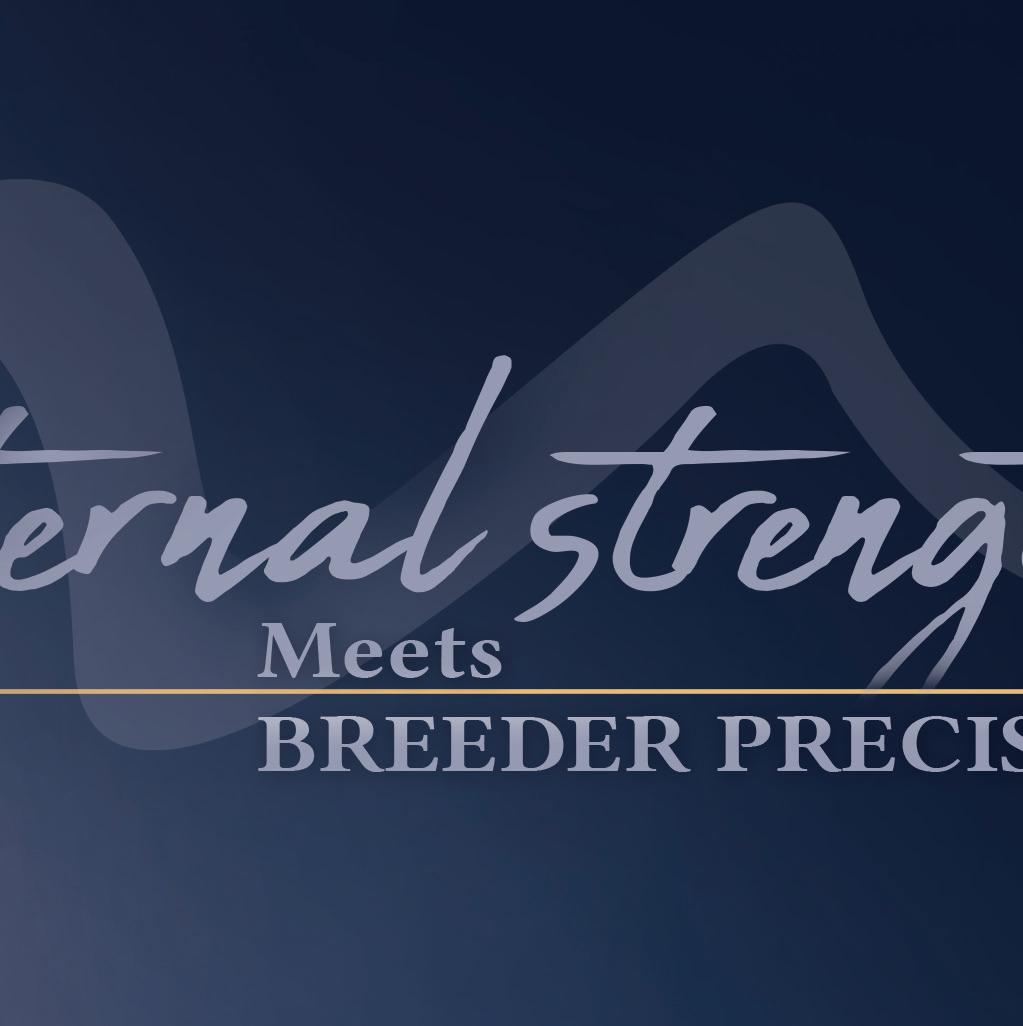

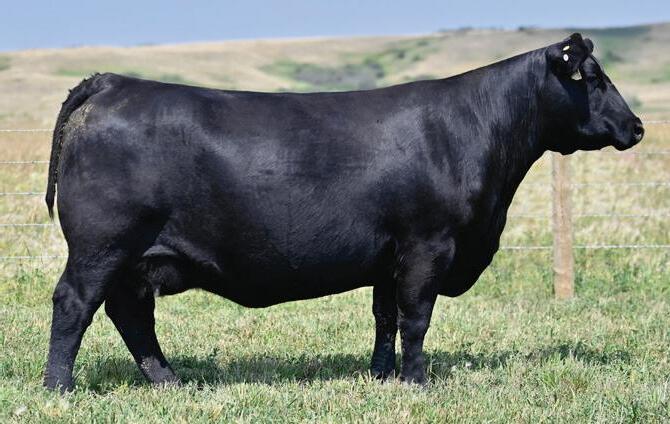
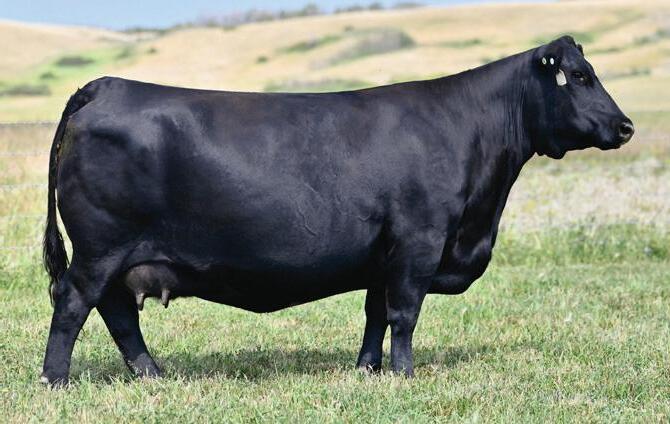





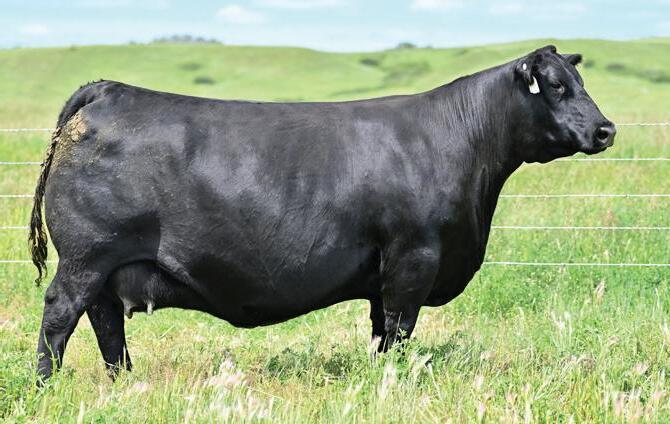

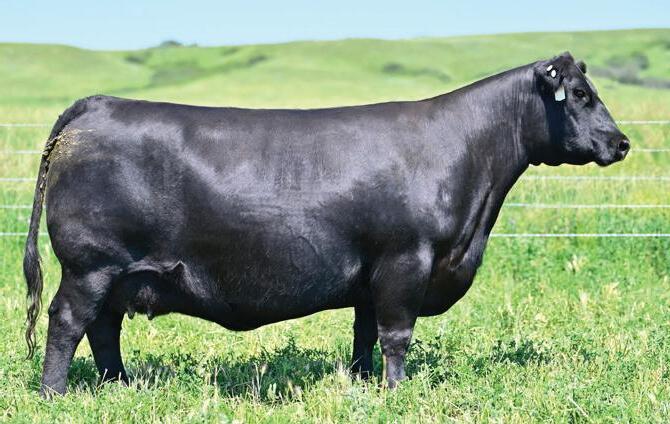



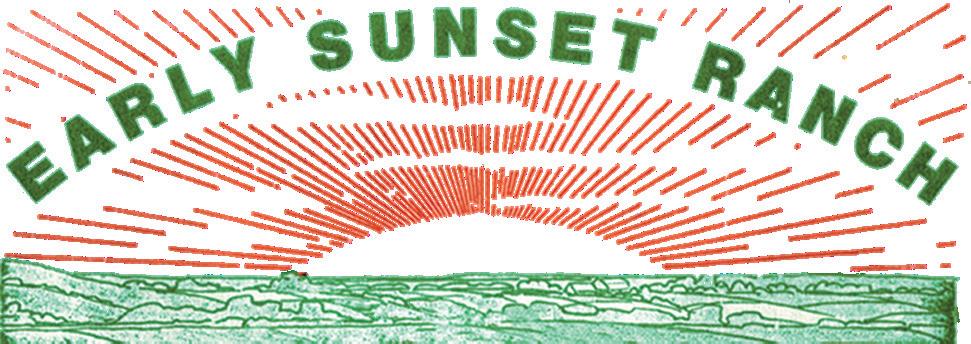





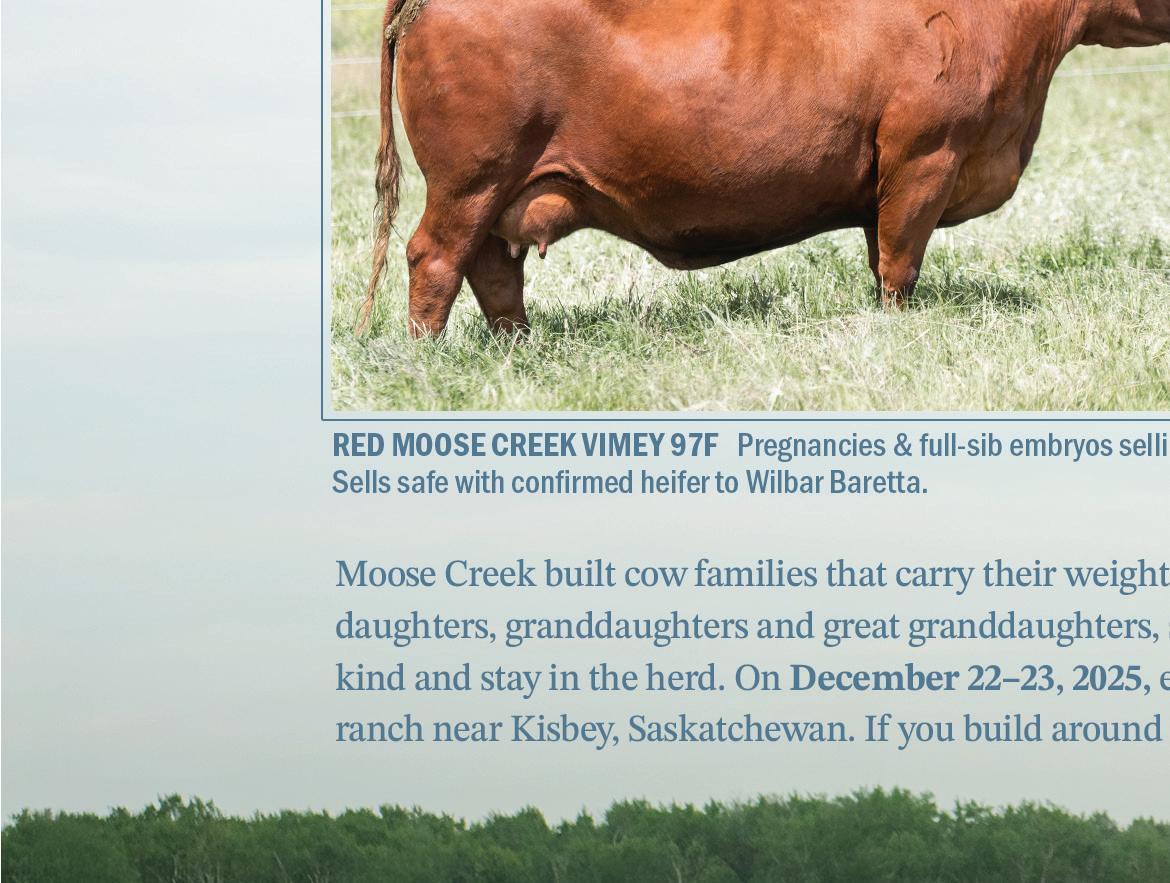


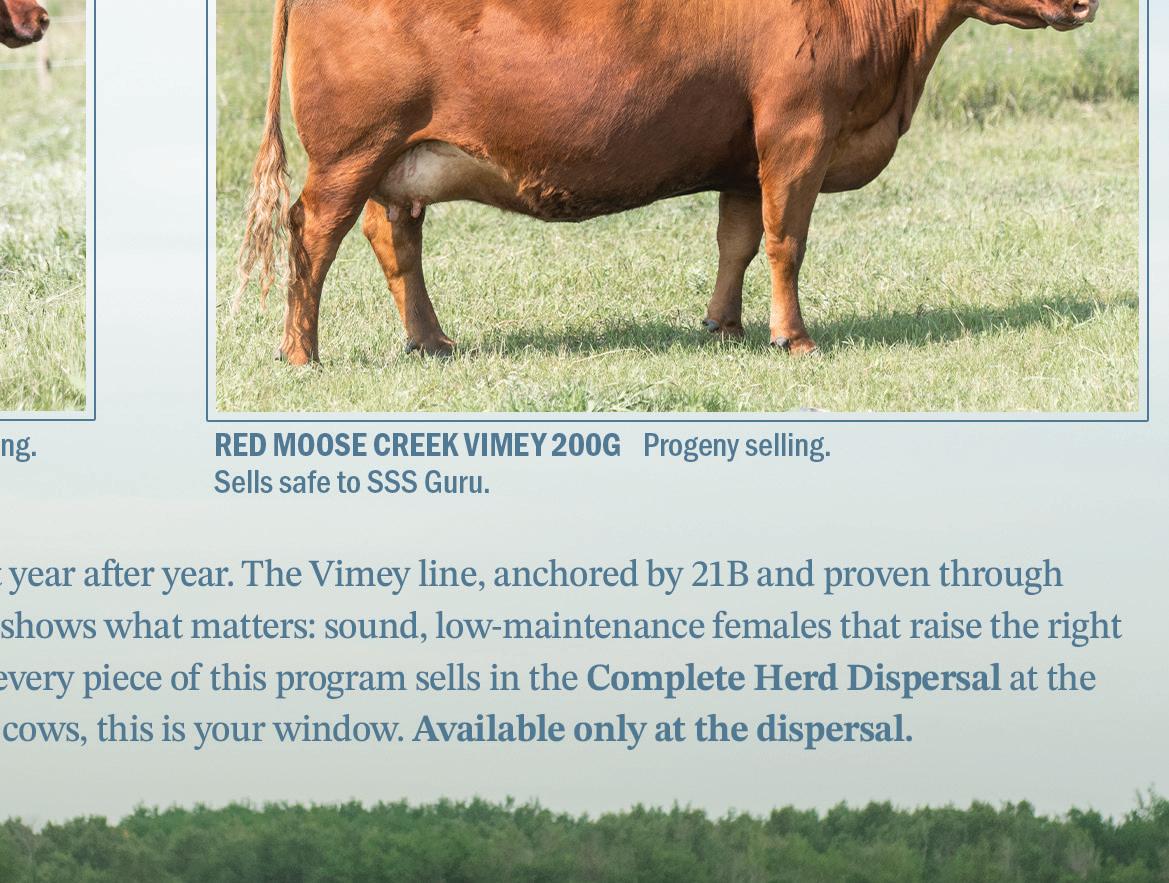
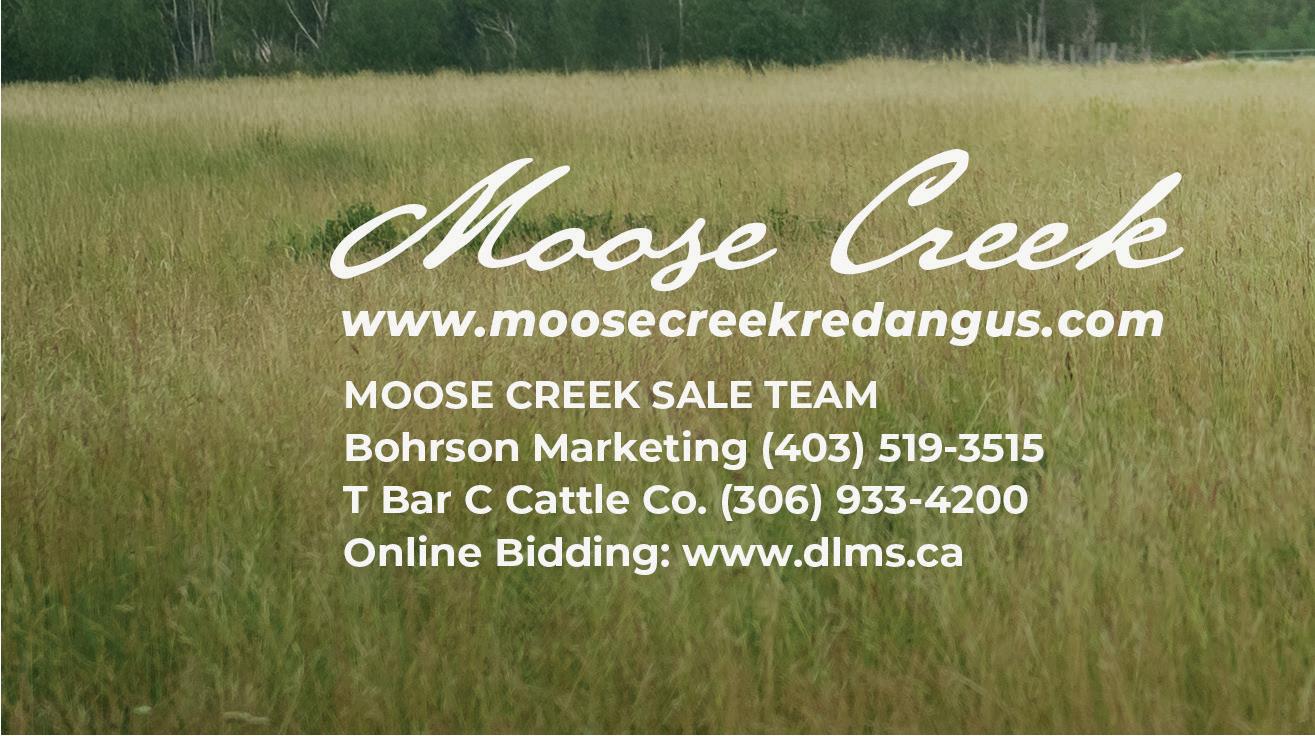

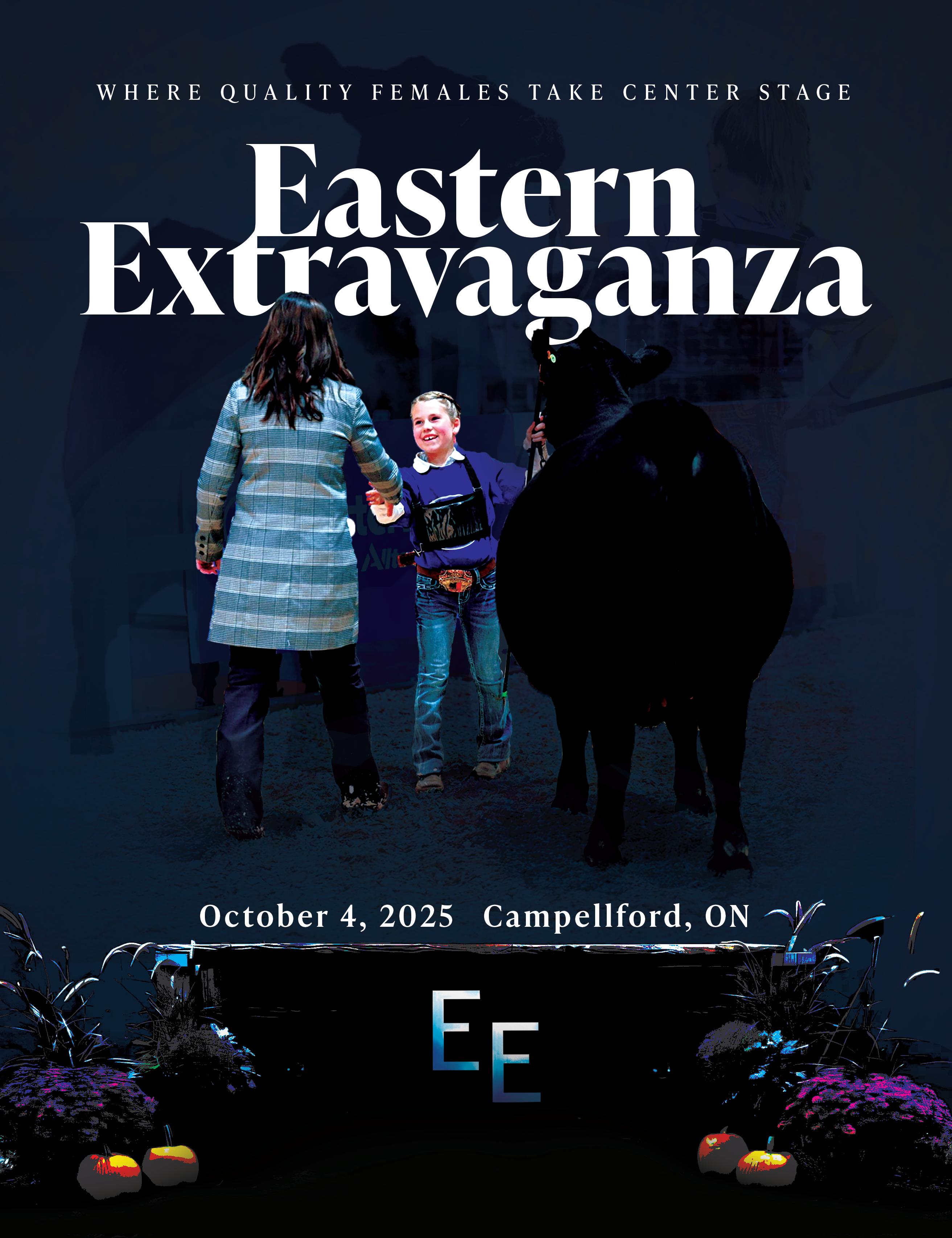















































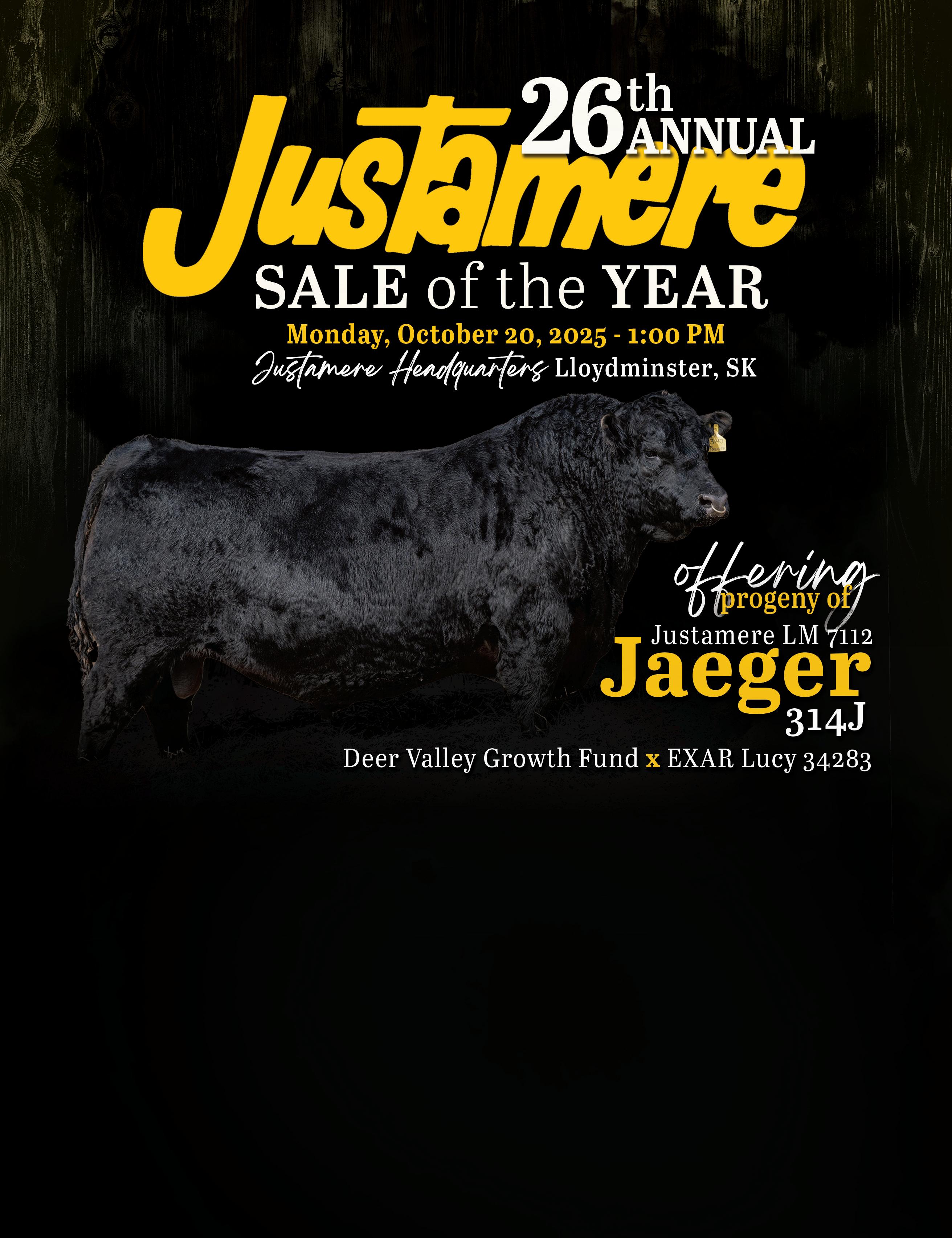
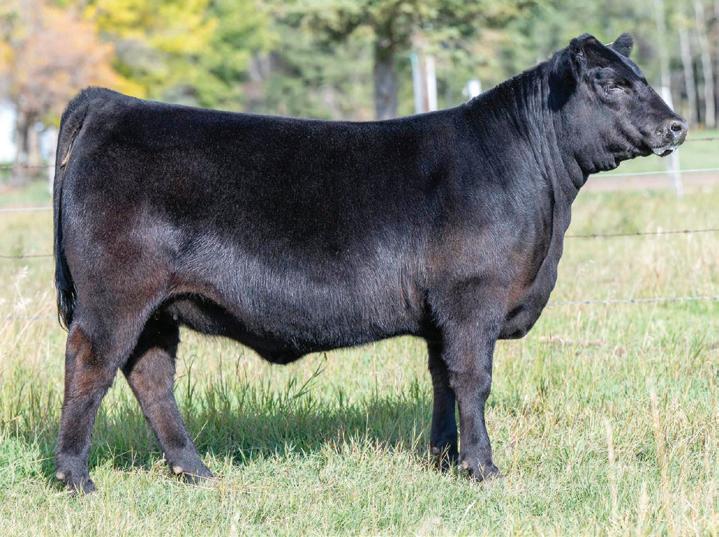



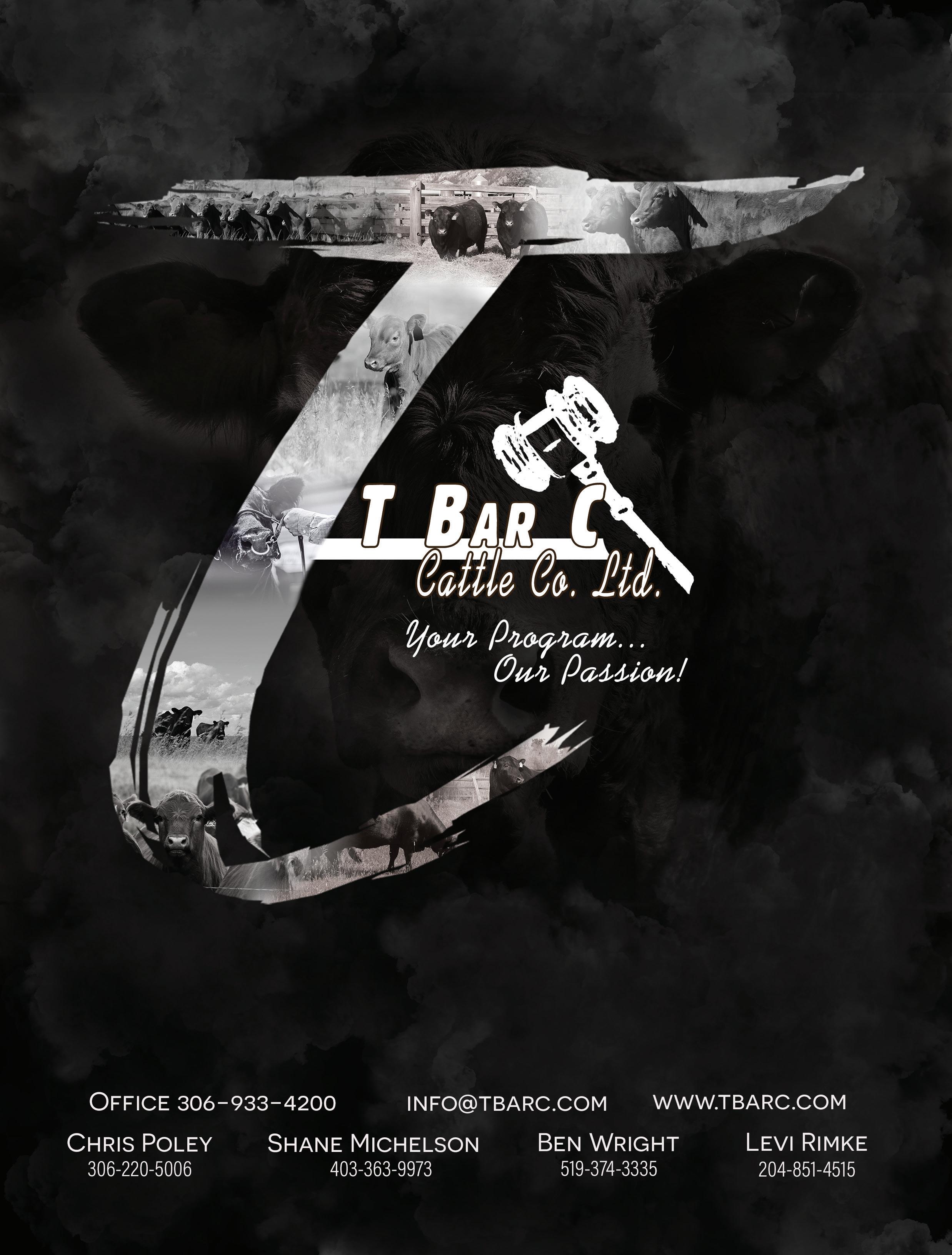

“2014 turned out to be an amazing year, actually a record in the beef cattle industry. Far beyond what many of us were predicting, even those much smarter than me or even Ted! With live cattle prices significantly higher, in some cases double what the same cattle sold for just a year prior. Many producers found themselves dealing with a problem they have not even thought about in more than a decade… tax. Finally, a problem you can deal with!”
“Still many producers are holding their breath wondering how long higher prices and profits will last. There are a lot of farmers and ranchers that feel that this is a dream and are skeptical to let themselves believe it has come true. I’m a believer that it is true and it is based on shear supply and demand, not politics or stock traders falsely affecting a market, demand remains strong, and supplies are low and tough to build.”
Today’s Angus Advantage Winter Edition 2015
An interesting timeline, as in 2015 fat cattle were $1.5252 USD. Since, there has been a shortage of rainfall in key beef producing areas, and the aging producer. Politics and inflation have
forced, (and I say forced) the market to comply with the shortages and as a result an increase in price rose to a favorable level to satisfy demand. The consumer has adjusted their shopping list as beef consumption is on the rise. They are tired of poultry and pork, and fish is too high, yet they are willing to pay more and buy Canadian with an assurance of quality and safety.
The fast-food market is a big player in the beef game… burger price wars are heating as they all strive to maintain their market share and whether you believe it or not, the biggest part of a carcass is marketed in a paper bag and out a drive through window. While the garden variety of plant-based burgers developed in a laboratory that was designed and marketed to overtake the beef trade has fallen flat and is virtually nonexistent… one company lost 80% of their share value while its counterpart declared bankruptcy…. It didn’t take long for the consumer to know they wanted real beef.
The bull market continues to run with virtually no resistance, the market is strong as records are set weekly just to be broken the following week. Old mature herd bulls gone to market have created capital gains. It is difficult to predict the
short-term market, but the longevity of the beef cattle business gets stronger and longer each year. Rebuilding and replenishing the landscape will take some high-priced time and may never be fulfilled.
This great movement in the livestock industry has fostered an exciting sector… that being the young adults of our nation. With the increase in the price of purchasing and marketing, whether it be prospect steers or bred heifers there is a new generation up and coming in all beef breeds. Jackpot shows have sprung up with virtually a competition every weekend. These events are both educational and social as these leaders of tomorrow compete and learn about raising and marketing for their future in the livestock industry. It takes effort and dedication by the juniors, their parents, volunteers and especially the sponsors who contribute premiums that are used for higher education or the purchasing and selection of the following year’s project. The question I ask is why our government subsidies and supports foreign endeavors and forgets to support the future of our great nation right in front of their eyes.

By Roy Lewis,
I have never looked at foot rot individually. Perhaps it is the fact the response to treatment with basic antimicrobials is very good for true foot rot. But it is probably the one disease that is very much over diagnosed when it comes to lameness and thus overtreated.
With lame cattle one has to have a very good look and diagnose the lameness lower leg or upper leg and if in the foot, is there swelling associated with the lameness. If lower leg in the foot with swelling and often a smell coming from between the toes or lots of swelling present, then it is most likely foot rot. The response to treatment is also generally a telltale sign with most foot rot being very responsive when the appropriate antibiotic is given. Often the antibiotic could be the penicillin’s tetracyclines or even macrolide antibiotics like draxxin as an example. In more modern times, the dart guns have been used on pasture and so the macrolides with a lower dosage makes such antibiotics a good choice. Foot rot is caused by a bacteria gaining access that grows without oxygen and gains entrance from a break or weakness in the skin between the toes or could also be by a penetrating wound. Again, the bacteria grow without oxygen, so mud caked, or manure caked feet sets up the ideal environment. Seen much more in the feedlot or in very wet marshy conditions at pasture. Keeping areas cleaned around watering bowls and feedlot pens cleaned will go along way to preventing foot rot. Feedlot pens with lots of manure need cleaning and I believe those using the RCC [roller compacted concrete} have way less foot problems as one of its many benefits.
One of the biggest problems we as veterinarians still see is over diagnosis of foot rot. Any lame animal should not be considered foot rot. It is one area where there is likely overuse of antimicrobials. Sprains strains clear up with rest and nothing or in severe cases Nsaids. Septic arthritis or severe corns may need surgical intervention. Bad cracks or sole abscesses need foot trimming and care. Interdigital dermatitis needs another type of treatment.
Treating quickly eliminates the emergency slaughter plan so check out thoroughly before jumping to treatment. Occasionally we will see the stifle injuries need rest time and may be permanent where cows or bulls are culled. Fractures may be cast splinted or higher ones emergency slaughtered if mature bulls or cows. You can see how response to treatment is a bit of a diagnostic tool. If they don’t respond to treatment for foot rot it is very likely something else.
For most common foot rot, common antimicrobials will work and in the old days removing more of the necrotic tissue exposes the area to air and the condition improves. In fact, exposing the infected area to air could be curative without antibiotics. There is however a great need to prevent this disease from occurring in our breeding bulls. The foot rot disease is mainly caused by one specific organism fusobacterium necrophorum and occasionally a couple others, but the main one is in the foot rot vaccine.
There has been a trend over the years of more and more purebred breeders having the foot rot vaccine administered prior to delivery or pick up of the bull. The purebred breeders see this as a valuable preventative measure on their breeding bulls. Having a cow, heifer or calf come down with foot rot is one thing but a breeding bull right in the middle of breeding season and having them down and lame for even a few days is very costly. Add to that the fact that bulls are much harder to catch and treat. Yes, dart guns may have made that easier and quicker but there is still the recovery time and missed breedings by a lame bull. Breeding season is tough on a bull’s feet at the best of times especially the back feet when they mount so keeping their feet in as good a health as possible is imperative to a good breeding season. The purebred breeders get you started, and it should be listed in the sales catalogue but often it isn’t, so asking the specifics when purchasing your bull. Did the bull receive both the initial and booster shot of the vaccine with about the month to six weeks between the initial and booster shot.
To me the purebred breeders that do this are setting you up for success if you continue to maintain the booster shot yearly. The ideal time is at semen testing time the bull is caught, and it is just before breeding so an ideal time to administer the booster and get maximum protection by breeding season. Since mature bulls are harder to contain and handle the vaccine should be administered when in the process of electroejaculation when totally safe to do so. It is a low dose subcutaneous vaccine so lots of safe places it can be given. It is also a time when we are looking at the feet and legs of the bulls and can correct any other foot issues we see with a foot trim and grinding out cracks. Routine foot trims when needed definitely extend the life of our breeding bulls of that there is no doubt in my mind.
Some veterinary clinics I know carry the vaccine with them and promote its use when semen evaluating and can then charge for it on a doseby-dose basis. It is a killed bacterin (like blackleg) and only comes in a ten-dose container. Immunity is not real long lived so I recommend on these valuable breeding bulls that are used in two breeding seasons say six months apart that you revaccinate before the start of the next breeding season.
We all know prevention is far better than treatment. I have on occasion recommended foot rot vaccine to a client that always pastured wet pastureland on lots of muskeg simply because his foot rot rate got too high. Again, response to foot rot medication is good in the feedlot but the cost of treatment labour and the fact the feedlot animal is in pain and not eating as well is reflected in less gain.
When treating one case we always think of prevention. Can a wet environment be changed should a feedlot pen be cleaned up. Also, the precaution that make sure the clinical signs, feet if there is no swelling in the foot and the toes spread apart and the foul odor it is something else. Interdigital dermatitis has been a big problem in dairies and just getting into some beef feedlots. It is the disease most similar to foot rot, but a close exam will tell you what you’re really dealing with.
Over the years there has been many lameness’s wrongly treated because a super quick diagnosis of foot rot was made. If you made this mistake, you know because there was no response to the medication. With most lameness’s except those going to slaughter veterinarians will often prescribe a NSAID for the pain and inflammation. Foot rot would be no different for sure recovery is quicker and we maintain foraging and movement for feed or water.
When treating foot rot make sure your diagnosis is right and really think of vaccination for foot rot in your breeding bulls as a possibility. It is a worthwhile investment but remember painkillers will really help in treating other lameness so have a protocol from your veterinarian on what to do in these cases as well or have them diagnosed. Lameness in cattle or many other species can be caused by many things and is one of the problems in cloven hoofed animals with most lameness involving the feet.


Announcer Bill Dietrich
JULY 24-26, 2025
Judges Doreen Blumhegan, Kaitlynn Bolduc, Jordie Buba, Wendy Coppock, Austin Cross, Bill Dietrich, Kodie Doetzel, John & Tammy Dolliver, Innovation Media, Judith Klappak, Christy Lavallee, Tony Le, Macy Liebreich, Millie Moore, Toby Noble, Rhonda O’Neill, Greg Pugh, Jodi Robertson-Wildman, Davis Schmidt, Brydelle Wardley, Mike Zoller.
Ringmen Bailey Dietrich, Dylan Fuller, Julie Sharp
Marshallers Tracy Dietrich, Ty Dietrich, Kendra Fischer, Brody Gardner, Blake Morton, Darcy Olesky, Camille Scott
Photographer Innovation Media

Auctioneer Don Oberg
Canadian Angus Association
Greg Pugh - President, Edgerton, AB
Myles Immerkar - CEO, Calgary, AB
Alberta Angus Association
President - Carey Kopp, Duchess Administrator - Jody Scheirlinck, Del Bonita
Mission Statement
Canadian Junior Angus will strive to present innovative opportunities to promote and educate future cattlemen dedicated to the Angus Breed.

PEEWEE EXHIBITORS Wacey Fisher, Raleigh Fisher, Jensen Jacobs, Madalynn Clough, Mallory Clough, Maverick Hunker,
Ivy Elliot, Arlen Murray, Wynne Henderson, Alayna McGowan, Emily Richards, Rigley Dietrich, Saylem Dietrich, Ames Wilson, Arrow Wilson, Nash Hunker, Jameson Hunker

Open Division || Grand Champion Female
DMM BLACKBIRD 39L Exhibited by Julius Wintereder
Open Division || Heifer Calf
(born on or after Jan 1, 2024)
Champion Heifer Calf
LLB Lavender Lady 30N Exhibited by Madison Hammell
Reserve Champion Heifer Calf
LLB Oakleaf 341N Exhibited by Maddie Ferrence
Open Division || Yearling Heifer (born on or after Jan 1, 2023)
Champion Yearling Heifer
FREYBURN BLACKBIRD 36M exhibited by Joran Frey
Reserve Champion Yearling Heifer
RED WILBAR SUE 832M exhibited by Kylie Willms

Open Division || Reserve Champion Female
FREYBURN BLACKBIRD 36M Exhibited by Joran Frey
Open Division || Two-Year-Old Female
(born 2022, with calf born on or after January 1, 2024)
Champion Two-Year-Old Female
DMM BLACKBIRD 39L exhibited by Julius Wintereder
Reserve Champion Two-Year-Old Female
SHEIDAGHAN GOLD PRINCESS 17L exhibited by Saige Buchanan
Open Division || Mature Female
(born prior to 2022, with calf born on or after January 1, 2024)
Champion Mature Female
FREYBURN GEORGINA 125K exhibited by Reegan Frey
Reserve Champion Mature Female
AJA ZELLA 803F exhibited by Ty Jungman

Owned Division || Grand Champion Female
TER-RON JAYBIRD 64M Exhibited by Kasey Adams
Owned Division || Heifer Calf (born on or after Jan 1, 2024)
Champion Heifer Calf
TER-RON ROSEBUD 2N exhibited by Kasey Adams Reserve Champion Heifer Calf RED RIVER ROCK SHAWNEE 19N exhibited by Karsen Van Sickle
Owned Division || Yearling Heifer (born on or after Jan 1, 2023)
Champion Yearling Heifer
TER-RON JAYBIRD 64M exhibited by Kasey Adams Reserve Champion Yearling Heifer
RUST BEAUTY 4422 exhibited by Riley Bohrson

Owned Division || Reserve Champion Female RUST BEAUTY 4422 Exhibited by Riley Bohrson
Owned Division || Two-Year-Old Female (born 2022, with calf born on or after January 1, 2024)
Champion Two-Year-Old Female
DMM KRISTINA 65L exhibited by Navada Murray Reserve Champion Two-Year-Old Female
BROOKING ROSE 3030 exhibited by Paisley Robertson
Owned Division || Mature Female (born prior to 2022, with calf born on or after January 1, 2024)
Champion Mature Female RED WILBAR BAYBERRY 31K exhibited by Kylie Willms Reserve Champion Mature Female RED SHILOH DYNA 78K exhibited by Logan Brooke

Bred & Owned Division || Grand Champion Female CINDER ROSETTE 617M Exhibited by Tavianne Yoder
Bred & Owned Division || Heifer Calf (born on or after Jan 1, 2024)
Champion Heifer Calf
LLB BARDESS 1N exhibited by Luke Henderson
Reserve Champion Heifer Calf
QUILL ACE PRIDE 4N exhibited by Abby Tomblin
Bred & Owned Division || Yearling Heifer (born on or after Jan 1, 2023)

Bred & Owned Division || Reserve Champion Female RED BCC RENEE 435 Exhibited by Wynton Brandl
Champion Yearling Heifer CINDER ROSETTE 617M exhibited by Tavianne Yoder
Reserve Champion Yearling Heifer RED BCC RENEE 435 exhibited by Wynton Brandl
Bred & Owned Division || Mature Female (born prior to 2022, with calf born on or after January 1, 2024)
Champion Mature Female SHELBY’S SCOTT LENA 202H exhibited by Shelby Scott
Reserve Champion Mature Female BROOKE ANNIE K 2K exhibited by Luke Brooke

Bull Division || Grand Champion Bull
BCC PERCEPTION 496 Exhibited by Landon Brandl
Bull Division || Bull Calf
(born on or after Jan 1, 2024)
Champion Bull Calf
LLB PROLIFIC 126N exhibited by Luke Henderson
Reserve Champion Bull Calf
RIVERFRONT FOUR MILE 508N exhibited by Paisley Robertson
Bull Division || Yearling Bull (born on or after Jan 1, 2023)
Champion Yearling Bull
BCC PERCEPTION 496 exhibited by Landon Brandl

Bull Division || Reserve Champion Bull RIDEAU EXECUTIVE 12L Exhibited by Joran Frey
Bull Division || Two-Year-Old Bull (born on or after Jan 1, 2022)
Champion Two-Year-Old Bull RIDEAU EXECUTIVE 12L exhibited by Joran Frey

Commercial Division || Champion Female
CD LINDA 4200 Exhibited by Sienna Bohrson
Commercial Division || Heifer Calf
(born on or after Jan 1, 2024)
Champion Heifer Calf
DIAMOND T MISS 2506 exhibited by Faith Collins
Reserve Champion Heifer Calf
RED CINDER BAYBERRY 38N exhibited by Brynne Yoder
Commercial Division || Yearling Heifer (born on or after Jan 1, 2023)
Champion Yearling Heifer
CD LINDA 4200 exhibited by Sienna Bohrson
Reserve Champion Yearling Heifer
RIVERFRONT BIRDIE 59M exhibited by Dryden Robertson
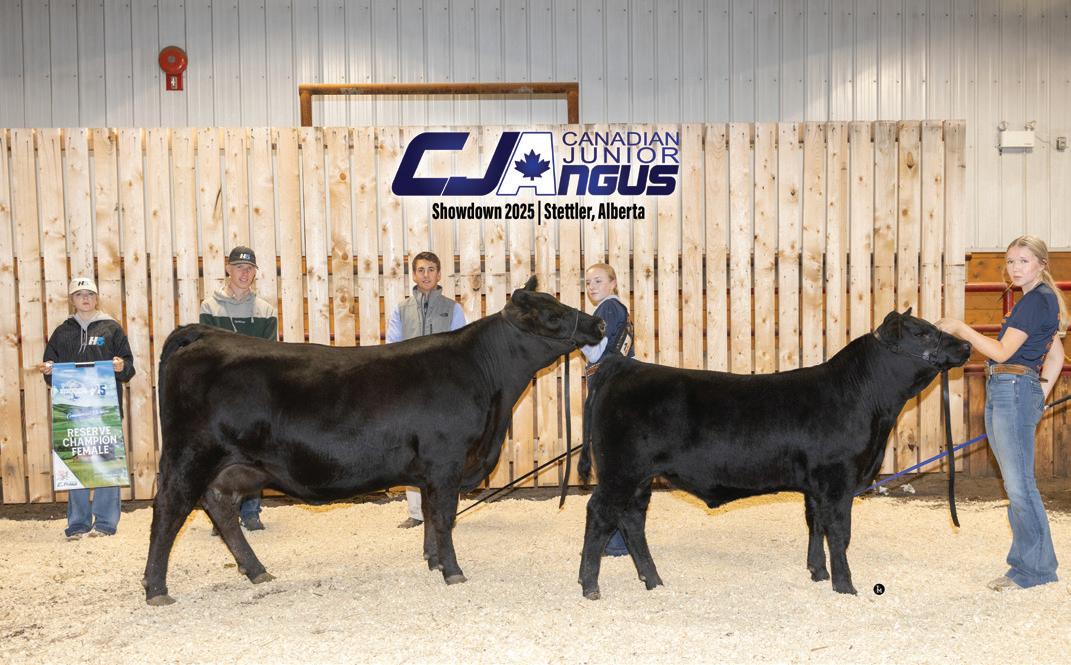
Commercial Division || Reserve Champion Female
SOG Daisy 88L Exhibited by Emily Hartle
Commercial Division || Two-Year-Old Female (born 2022, with calf born on or after January 1, 2024)
Champion Two-Year-Old Female
PJH MISS MOCHA 42L exhibited by Paytin Hagel
Reserve Champion Two-Year-Old Female
FAIRLAND BARBIE 36L exhibited by Reed Howell
Commercial Division || Mature Female (born prior to 2022, with calf born on or after January 1, 2024)
Champion Mature Female KARISSA exhibited by Trigg Pedersen

Commercial Division || Champion Steer
Exhibited by Riley Bohrson

Commercial Division || Reserve Champion Steer

Angus Division || Champion Female
by Kylie Willms
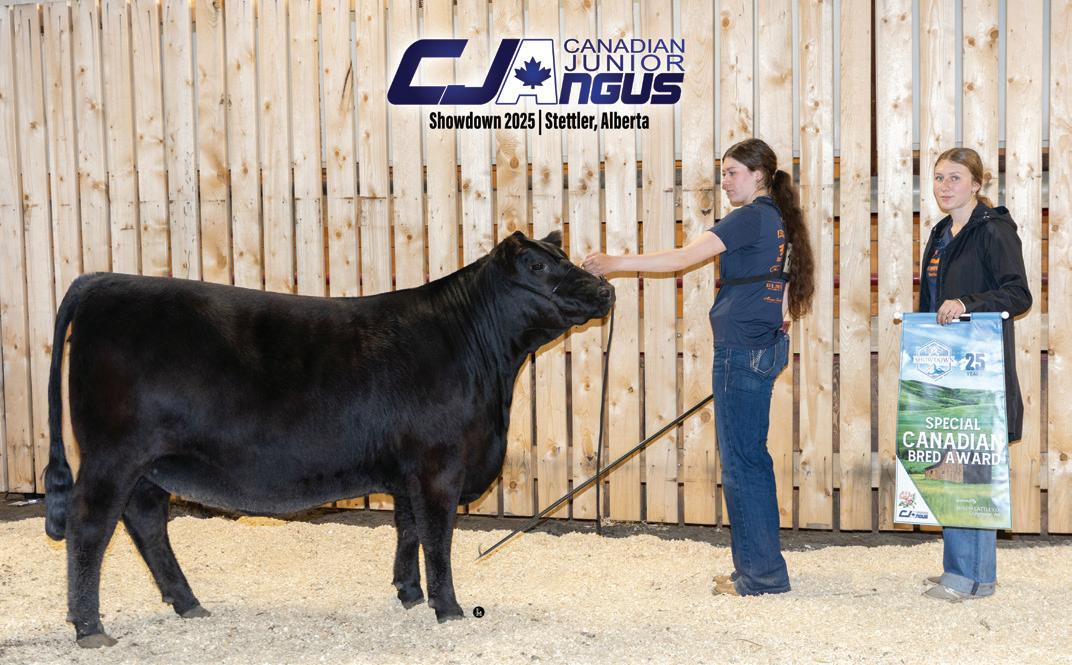
Special Canadian Bred Division || Champion Female CINDER ROSETTE 617M Exhibited by Tavianne Yoder

Angus Division

Heifers were judged 50% on genomic EPD’s prior to the show and 50% on conformation at the show.
Champion Heifer of Distinction
FREYBURN BLACKBIRD 36M exhibited by Joran Frey Reserve Champion Heifer of Distinction
GOLD-BAR ECHO 101M exhibited by Kaycee Buchanan 3rd Place
CUDLOBE PRINCESS 118M exhibited by Kilee Lange 4th Place
GOLD-BAR HEROINE 107M exhibited by Saige Buchanan 5th Place
CUDLOBE EFFIE 131M exhibited by Sarah Niznik






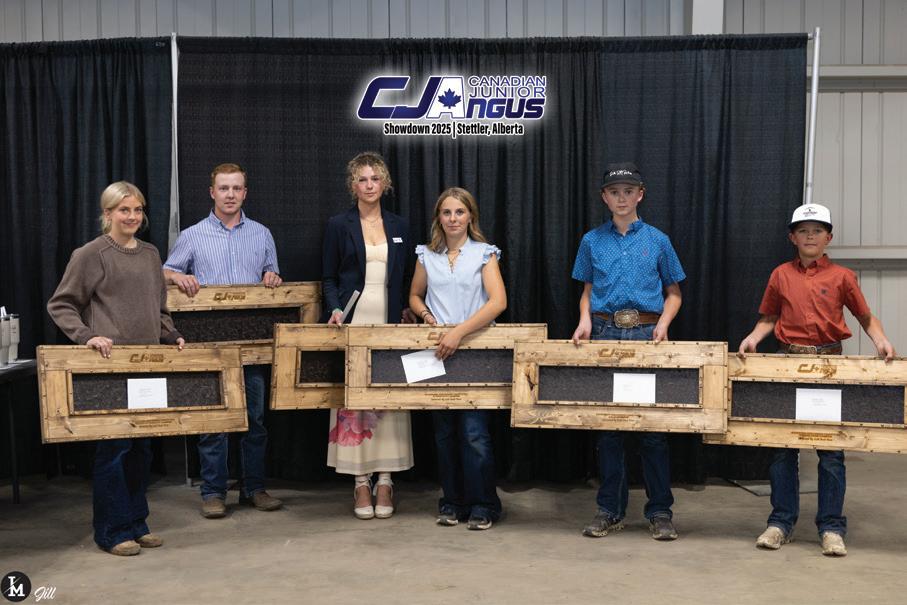









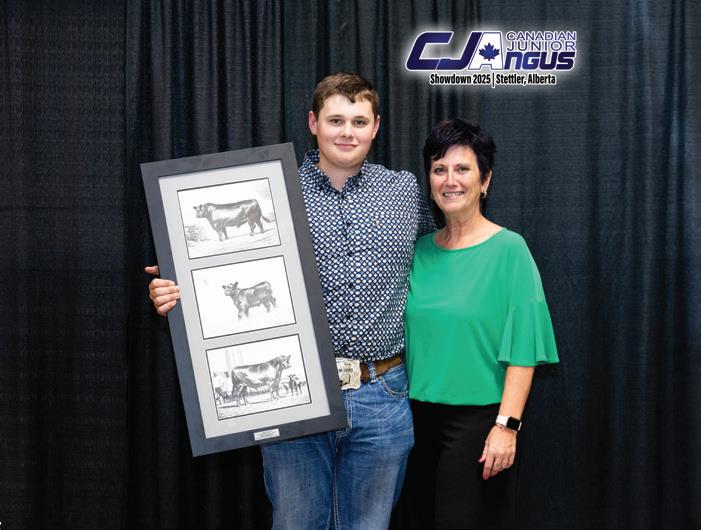
https://www.cdnangus.ca/canadian-junior-angus/showdown/


This spring brought exciting milestones for the brand. March turned out to be our best sales month ever, with 116.8 million pounds of the Certified Angus Beef ® brand products sold. It was also a standout month for quality, with 86% of fed cattle carcasses grading Choice or Prime, the highest annual mark once again. And here’s another impressive streak: USDA Prime has outpaced Select for nine weeks in a row, thanks in part to heavier carcass weights and longer feeding periods. The share of Angus-type carcasses certified for CAB has also been above 40% since the beginning of March (minus one week), peaking at 44.5% in April. The 2024 fiscal year CAB acceptance rate averaged 37.4%. Amidst another year of challenging market dynamics, we’re taking wins where we can.
Global Appetite for Prime
What happens when you walk into a grocery store thousands of miles from the U.S. and find Certified Angus Beef ® Prime as the showpiece of the meat case? You get a clear message: the demand for high-quality beef is global and Prime is in the lead.
In the Dominican Republic, where nearly all premium beef is imported, retailers are making CAB Prime the centerpiece of their

fresh beef programs. Not tucked in a corner, not part of a long list of options, but front and center. They’re building their case around it, using bold signage, sharp merchandising and clear storytelling that highlights flavor, quality and consistency. Even in stores that support regional or breed-specific programs, Prime is the product they elevate to stand out.
This kind of presence doesn’t happen by accident. It’s the result of a growing global customer base that knows what exceptional beef looks and tastes like and is willing to pay for it. That opportunity starts long before the meat case. It starts with you.
Every CAB Prime cut on a shelf in the Caribbean or anywhere else in the world is tied to the work you do—breeding, feeding and managing for quality. As international demand continues to rise, it reinforces what many of you already know: cattle that can hit that Prime grade are worth more. And the market is proving it, again and again.

New to the menu is a partnership with Certified Angus Beef and Sabatino—a premium truffle brand. With the foodservice industry emphasizing flavor and passion behind brands, this partnership highlights the quality on the plate while creating new flavors to meet consumer demand.
Sabatino has been family-owned and operated since 1911, beginning in Italy and making its way to the world’s top truffle brand, while prioritizing sustainable practices for its truffle oils, seasonings and preserved truffles. Certified Angus Beef, serving the industry for over 45 years, maintains the same passion for its beef, bringing flavor and consistency to tables across the globe.
Both brands recognize the demand for flavor, innovation and quality desired by chefs and consumers. Certified Angus Beef and Sabatino bring forward a legacy of quality, and this partnership opens high-end opportunities for chefs to create culinary experiences guests remember. The yearlong partnership also features exclusive dishes that incorporate Sabatino truffles at CAB events, new product ideas and social media content that inspires home cooks.
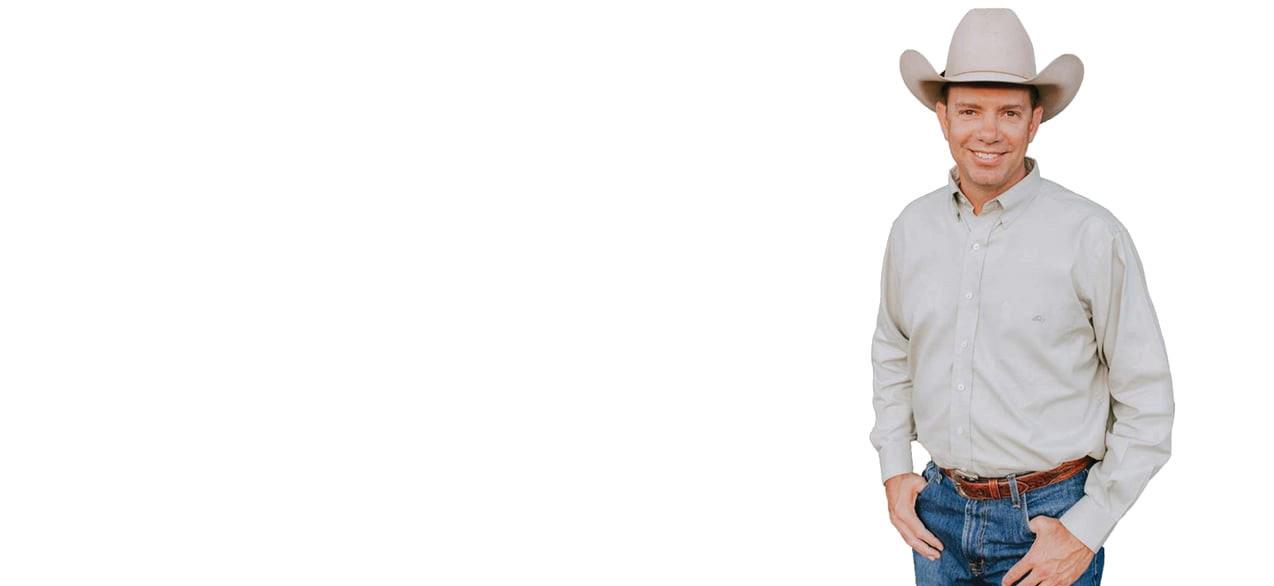
PAUL DYKSTRA Director, Supply Manager & Analysis
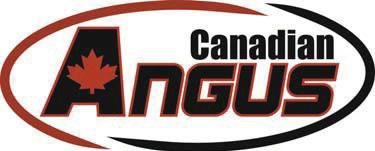
292140 Wagon Wheel Blvd • Rocky View County, AB T4A 0E2 Phone: (403) 571-3580 Fax: (403) 571-3599
June 18, 2025: for immediate release
Rocky View County, AB—Over the weekend, more than 100 Angus enthusiasts gathered in Winnipeg, Manitoba for the Canadian Angus Association (CAA) National Convention and Annual General Meeting. Highlights include:
Rocky View County, AB Over the weekend, more than 100 Angus enthusiasts gathered in Winnipeg, Manitoba for the Canadian Angus Association (CAA) National Convention and Annual General Meeting. Highlights include:
• Greg Pugh of Edgerton, AB was elevated from the position of President Elect to President. Ronnie Ford of Oyster Bed, PEI moved into the Past President position, and Robbie Garner of Simpson, SK was chosen as President Elect. In addition, the Board welcomed Chelsea Gill of Cypress County, AB and John Parkes of Merritt, BC In addition, they would like to thank Tom deWaal and Blake Morton for their service on the Board of Directors.
• Greg Pugh of Edgerton, AB was elevated from the position of President Elect to President. Ronnie Ford of Oyster Bed, PEI moved into the Past President position, and Robbie Garner of Simpson, SK was chosen as President Elect. In addition, the Board welcomed Chelsea Gill of Cypress County, AB and John Parkes of Merritt, BC. In addition, they would like to thank Tom deWaal and Blake Morton for their service on the Board of Directors.
to maintain full control over sample handling and storage. This shift focused on a number of needs that was led by data security, long-term service and future opportunities that can be explored such as increasing the frequency of the genetic evaluation runs that will be updated this fall.
• Immerkar announced that the CAA will soon launch AngusHOME, a new database program for managing the Canadian Angus Association herdbook.
• At the Convention cocktail party, two awards were presented for 50 years of continuous CAA membership to Caine Cattle Co of Alberta and to Gold-Bar Livestock of Saskatchewan.
• CEO Myles Immerkar presented the 2024 audited financial statements at the AGM. He reported a successful year, strongly driven by the uptick in registrations and strong investment market which contributed significantly to exceeding budget for 2024. The Association’s annual report can be viewed online at www.cdnangus.ca/wp-content/uploads/2024-Annual-Report.pdf.
• CEO Myles Immerkar presented the 2024 audited financial statements at the AGM. He reported a successful year, strongly driven by the uptick in registrations and strong investment market which contributed significantly to exceeding budget for 2024. The Association’s annual report can be viewed online at www.cdnangus.ca/wpcontent/uploads/2024-Annual-Report.pdf.
• After announcing at the 2023 Convention that the CAA would explore the market value for Angus Central through an active market listing, it was announced that the Board accepted an offer to sell the building in November 2024 and conditions were waived in May 2025, with the official closing on June 27th. After closing, the CAA has gone into an 18 month lease agreement with the new owners while the CAA explores a number of future options.
• CAA Past President Bill Jackson and his wife, CAF Past Chair, Sylvia Jackson of Tullamore Angus were inducted into the Canadian Angus Hall of Fame.
• In 2024, the Canadian Angus Association (CAA) introduced a significant change to its DNA processing protocols, enabling collaboration with multiple laboratory partners. By routing all DNA samples through the CAA office, we now have the ability to proactively identify and resolve potential issues before samples reach the lab. This shift also enhances data security, as it allows the Association to maintain full control over sample handling and storage. This shift focused on a number of needs that was led by data security, long-term service and future opportunities that can be explored such as increasing the frequency of the genetic evaluation runs that will be updated this fall.
• After announcing at the 2023 Convention that the CAA would explore the market value for Angus Central through an active market listing, it was announced that the Board accepted an offer to sell the building in November 2024 and conditions were waived in May 2025, with the official closing on June 27th. After closing, the CAA has gone into an 18 month lease agreement with the new owners while the CAA explores a number of future options.
• Immerkar announced that the CAA will soon launch AngusHOME, a new database program for managing the Canadian Angus Association herdbook.
• In 2024, the Canadian Angus Association (CAA) introduced a significant change to its DNA processing protocols, enabling collaboration with multiple laboratory partners. By routing all DNA samples through the CAA office, we now have the ability to proactively identify and resolve potential issues before samples reach the lab. This shift also enhances data security, as it allows the Association
• At the Convention cocktail party, two awards were presented for 50 years of continuous CAA membership to Caine Cattle Co of Alberta and to Gold-Bar Livestock of Saskatchewan.
• Friday morning featured an engaging lineup of speakers, beginning with Mandi Tilleman of the Canadian Angus Association, who provided a live demonstration of the new AngusHOME program. Garner Deobald from Bovigen delivered valuable insights into herd health management, while Kajal Latimer presented exciting updates on research and technology within the Association—including the launch of three new maternal EPDs: Functional Longevity, Udder, and Teat. Melinda German from the Canadian Beef Check-Off Agency continued the session with a breakdown of how check-off dollars are allocated to support the beef industry. Our last speaker was Brett Gardiner, who kept us engaged while sharing about mental health in the agriculture industry. In the afternoon, attendees enjoyed a Manitoba Angus Association-hosted excursion exploring Winnipeg’s iconic Forks district and a tour of the Canadian Museum for Human Rights. The day concluded on a high note with an evening of networking and laughter, courtesy of comedian Matt Falk. Page 1 of 6

Tullamore Farms, operated by the Jackson family, stands as one of Canada’s most enduring registered Angus herds, continuously active since 1923. With a legacy marked by excellence in the show ring, the Jacksons have captured numerous titles over the decades, including Grand Championships at the Royal Agricultural Winter Fair in 1948, 1949, 1952, and 1960. Their genetics have consistently produced champions, such as the Ontario Show Bull and Female of the Year in 2012 and 2014, and most notably, Graco Conversation 14F, the 2019 Ontario Angus Show Bull of the Year and Canadian Angus Gold Show Junior Champion. Their cattle have had global impact, with Tullamore genetics exported to countries around the world including Russia, Australia, and Great Britain.
Beyond the show ring, Bill and Sylvia Jackson have each made significant contributions to the Angus breed. Bill served as President of both the Ontario and Canadian Angus Associations, while Sylvia was instrumental in the growth of the Canadian Angus Foundation, leading as Chair from 2014 to 2017. In recognition of their centurylong commitment, the Jacksons have been honoured with the 50-, 75-, and 100-Year Heritage Awards, a distinction held by only a select few. After nearly a century on their original property, Tullamore Farms relocated in 2022 to Zephyr, Ontario, where the Jacksons continue their proud tradition of raising quality Angus cattle. The Canadian Angus community extends sincere thanks to Bill and Sylvia for their remarkable dedication and impact on the breed.

The Caine Cattle Company (CCC) began in 1964 when Alice and Bob Caine started farming near Edmonton. By 1967, they were raising a commercial herd featuring Angus, Hereford, and crossbreds, which led to a shift to purebred Angus by 1974. In 1975, Bob and son Russell bought their first Angus cows from Black Anchor Angus, officially launching CCC into the purebred Angus business. Throughout the next decade, they expanded the herd, held sales, and became active in the Canadian Angus community.
In the 1980s, Bob served as Treasurer for the 5th World Angus Forum, but the National Energy Program forced a herd dispersal in 1985. The family remained involved in agriculture—Bob and Alice restarted on a smaller scale, Russell served in the military and dentistry, and Alice launched a real estate business.
The legacy continued with granddaughters Jill and Jane. Jill, through her marriage into the Wildman family, helped revive CCC in partnership with Towaw Cattle Co., while Jane contributed to the Canadian Angus Association. Even after the final auction in 2007 and Bob’s passing, the fourth generation remains active in Angus cattle, carrying forward the family’s proud legacy.
Gold-Bar Livestock Ltd. was founded in 1975 by Joe Hasson Sr. and his son David, evolving from Chickory Lane Farm, which began in 1962 in Ariss, Ontario. Initially focused on market steers, they earned multiple championships at major shows including the CNE, RAWF, and Agribition.
The Angus herd was sold off in the mid-1970s to begin a Polled Hereford program, but a notable result of that transition was Castle Acres Lass 402J—the only Canadian-bred, -owned, and -shown Angus female to win Grand Champion at the National Western Stock Show in Denver.
Angus was always a part of the herd, but returned as the sole breed at Gold-Bar in 1991 with a focus on Red Angus. The herd earned repeated Premier Breeder and Exhibitor titles at RAWF and Agribition. Bulls like Red Gold-Bar Jackpot 103J and King V415 107K made a mark in the show and sale rings.
David and Angela Hasson’s daughters Keri, Sarah, Suzanne, and Dawn were active in 4-H and junior shows. In 2008, the Red Angus herd was dispersed and the farm transitioned to Sarah Hasson and Brad Buchanan. Now located in Caron, Saskatchewan, Sarah, her daughters Kaycee and Saige, and partner Paul DuSomme continue the Gold-Bar legacy, showing cattle across Canada and preparing to host the 51st Masterpiece Sale on October 17, 2025.
John Parkes manages Nicola Ranch near Merritt, BC and has been with the ranch for 18 years. The ranch is well known for Black Angus cattle and Quarter Horses. John was born in Quesnel, BC and grew up in southwest Saskatchewan where his extended family farmed. John and his wife Bobbi have two sons, Duke and Will.
Chelsea Gill operates Reverse GC Angus alongside her family in Cypress County. She makes up part of the 5th generation on the mixed grain and beef operation. They currently run around 100 head of red angus cows with a majority of them being purebreds. She started her journey into purebred red angus in 2017 after successfully competing in a college business competition and winning a grant to purchase her first set of purebred pairs. She continued to build a purebred herd with a heavy focus on breeding cattle that improve the breed while keeping the commercial cattlemen top of mind. During regular business hours, she can be found working at ATB as a commercial and agricultural lender.
The Canadian Angus Association (www.cdnangus.ca) is a not-for-profit association incorporated under the Animal Pedigree Act. The Association represents 2,700 members across Canada for the purposes of registering and recording the pedigrees of purebred Angus cattle and promoting the breed across Canada. Its member-approved mandate is to maintain breed registry, breed purity and provide services that enhance the growth and position of the Angus breed.

50 Year Heritage Award-Gold-Bar Livestock
From left to right: Myles Immerkar, CAA CEO; Sarah Hasson; Greg Pugh, CAA President

2024-2025 Canadian Angus Association Board of Directors
Front row, left to right: Roger Reynolds, Saskatchewan; Ronnie Ford, past president; Greg Pugh, president; Myles Immerkar, CEO; David Sample, Quebec
Second row, left to right: Mona Howe, Alberta; Paula Cornish, Ontario; Chelsea Gill, Alberta; Darren Ippolito, Saskatchewan
Back row, left to right: Dallas Johnston, Manitoba; Robbie Garner, Saskatchewan; BJ Scheirlinck, Alberta; John Parkes, BC

As the cattle cycle turns, the nuances of recordlow herd numbers and economic challenges have been at the pinnacle of conversations in cattle country. But conversations at the meat case? They’ve turned to rising beef prices. For Certified Angus Beef (CAB), supply and demand are instrumental pieces of the business—and this spring, business was good. Record-setting good.
In an otherwise tough time in the beef business, sales and supply records have been a bright spot. The positive numbers mean that quality beef production has not let up, and beef demand is holding. Consumers have proven the value proposition: the good stuff is worth a little more money, for a better eating experience.
Seasonally, carcass quality tends to rise in the spring, and consequently, the brand sees the highest CAB acceptance rates in those months. Spring production followed that trend, with March and April yielding historically high certified carcass numbers. Based solely on head count, the end of March produced the second largest week of CAB certified carcasses at 134,330, second to a week in February 2021 at 135,758—with the 2021 number largely due to a pandemicdriven backlog in processing.
If we take a step back and look at the numbers overall, brand-certified carcasses are up +1% year-over-year, despite fed steer and heifer harvest being down -3.5%. And when looking at the data further, the brand has seen Certified Angus Beef acceptance rates at 40% or higher for 10 weeks this spring, kicking off in March. For comparison, the average acceptance rate for fiscal year 2024 was 37.4%, up from 36% in fiscal year 2023.
While heavier carcass weights and March’s ribeye area specification change lend to a slight uptick in certifications, CAB supply is undoubtedly strong. The Choice to CAB spread has grown, with the Choice-Select spread widening even as higher quality carcasses have become more prevalent. But how? At the production level, cattlemen and women have focused on quality beef production through genetics and management. Genetics geared toward performance and profit, with the right management to make sure those cattle reach their full potential.
That focus, alongside increased days-on-feed and heavier carcass weights, has produced
By Lindsay Graber Runft

more Choice and Prime carcasses, with Prime driving the bus. Fiscal year-to-date, Certified Angus Beef brand Prime carcass numbers are up 8 percent, following an industry trend for increased Prime production.
Overall, percent USDA Prime numbers have remained higher than Select for nine weeks—another historic data point for the beef industry. On a carcass basis, total USDA Prime carcasses are up 6.2% from 2024. “If we make a better product, more consumers trust the product,” CAB president, John Stika says. “They buy more, and demand goes up—part of why quality will continue to resonate in our industry.”
With spring on its way out and summer on the horizon, grilling season is in full swing. Typically, an uptick in backyard barbeques equates to a bump in beef sales. For CAB, March tends to be the high spot—and it was record-setting this year. The final sales number revealed 116.8 mil-lion pounds sold in March 2025, besting March 2022’s record of 113.8 million pounds. And the train does not stop there. Certified Angus Beef brand sales in April marked an all-time high for the month, with April 2025 currently ranking as an overall Top 10 month for brand sales. As well, tonnage numbers show that May is on pace to record another strong sales month.
Prime production is up, and so are sales. Relatively, Certified Angus Beef brand Prime sales continue to outperform the rest of the brand.
More boxes of Prime means greater consistency in supply and therefore, expanded offerings. For retailers, that increased supply supports larger sections of CAB Prime in the meat case—knowing it will consistently be available week after week. And restaurants can feel confident in adding that item to a menu, too. That was more challenging when Prime product was only 2-3% of the marketplace, but a consistent 10-12% market share lends to the addition of Certified Angus Beef brand Prime to the menu.
Looking ahead to continued CAB brand growth, Prime production and sales are where the largest opportunity lies. With CattleFax’s fed cattle slaughter forecast ontrack for 600,000 less cattle moving through the packing plant, the opportunity for
brand growth is in improved quality grades. On the sales side, that means elevating the value of an entire carcass, not just the middle meats. And selling them at a premium of 5-6%. At the packer level, there’s more dollars added to the bottom line – and more reason to procure that type of cattle.
We can all agree that high-quality beef tastes better. But are consumers buying it? You bet.
“What we have learned from consumers is that when they try to determine the value proposi-tion, what ultimately opposes price in their decision-making is quality,” says Stika. “Ninety-five percent of consumers say quality is important when they are deciding on a beef purchase.”
From the 2025 Power of Meat study, the top 2 meat purchasing decision factors were price per pound and quality. Relative to price, 94% of consumers would splurge on a meat purchase when the time is right, such as for a holiday meal or during a sales promotion. (Power of Meat, 2025)
Specific to CAB, and premium meats in general, the customer base for premium beef contin-ues to grow. The expanded array of customers includes college campuses and multicultural markets—from Latin-focused retail or foodservice chains to Korean entities. Certain beef-centric cultures that may have previously served as an outlet for lowerquality (Select) beef are now transitioning to premium products.
The 2025 Power of Meat study revealed that 87% of consumers are interested in recipes and cooking tips to make premium, restaurantquality meals at home.
For a brand that does not own any product, the time-tested key to success has been selling high-quality beef as if there is always another box in the cooler. Creating demand for the logo, driving demand for Angus genetics.

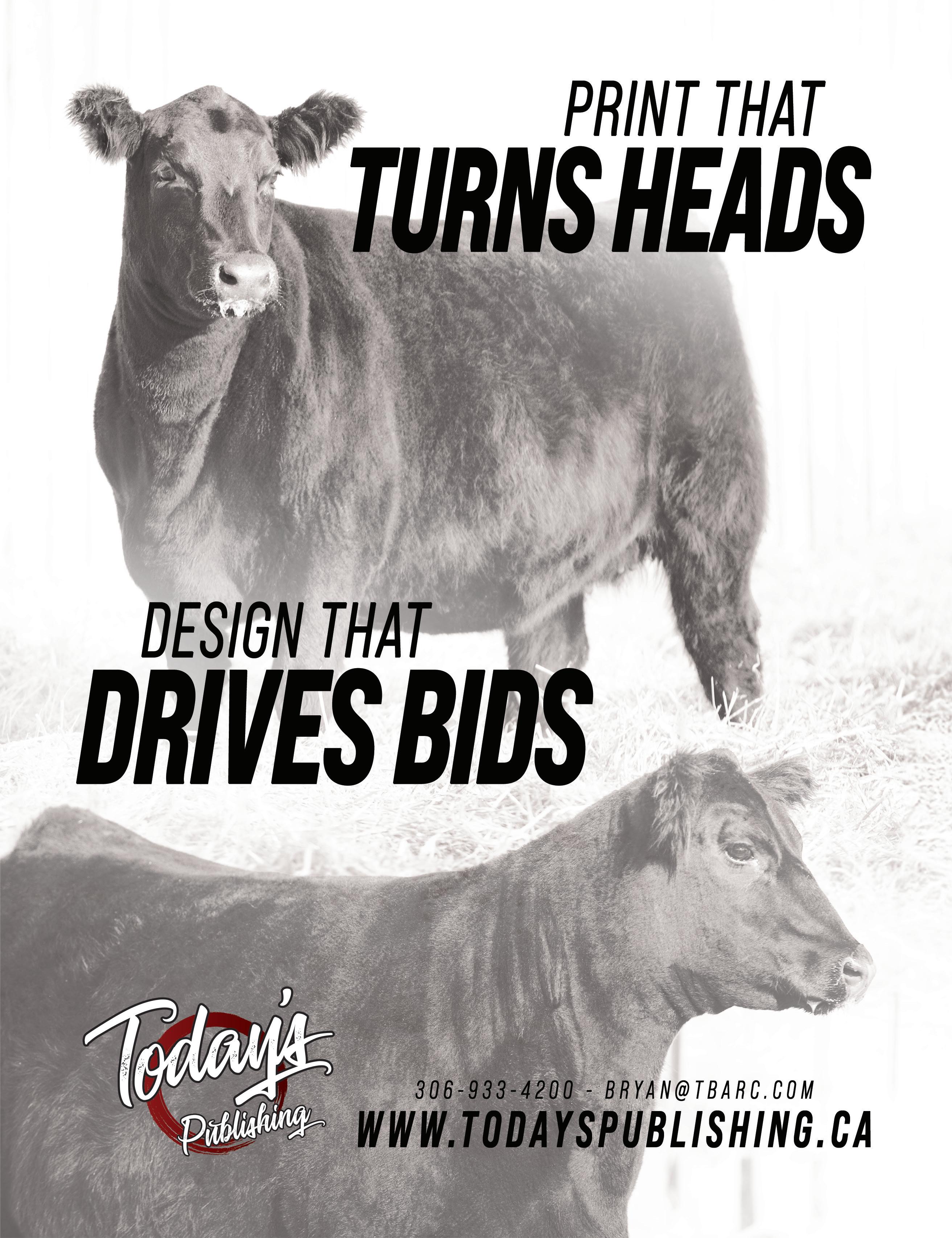
Office
Office





































An ambitious group of Angus breeders, from across the globe, attended the 2025 Beef Leaders Institute, spending a week learning about the beef supply chain.
Written by Ashlyn Murdock, Angus Communications Intern
June 27, 2025
For more information, contact: Holly Martin, director of communications: 816-383-5143 / hmartin@angus.org
The topic of the week was “from pasture to plate” as 23 Angus breeders left their cattle operations to spend five days looking at the big picture of the cattle industry as part of the annual Beef Leaders Institute (BLI), hosted by the American Angus Association® in collaboration with Certified Angus Beef and the Angus Foundation.
Closing the gap between producer and consumer can seem like a daunting task. However, BLI aims to help bridge the gap between producer to consumer by immersing attendees in all aspects of the beef industry. Each year participants leave with a better understanding of how their operations and efforts help deliver high-quality beef to families’ tables across the globe.
“It was a great experience to be able to see the whole industry,” said Kelsey Stabler, BLI 2025 attendee. “So much of our time is spent out in the field. It was nice to finally see on such a large scale, the pasture to plate process.”
Stabler is a fifth-generation farmer in Montgomery County, Maryland. Stabler works alongside her family on their 2,500-acre farm as they grow corn, soybeans and wheat and raise 120 Angus cows. Montgomery Country is located just one county north of Washington, D.C., providing Stabler with the opportunity to connect with consumers. Her family hosts many tour groups to learn about farming and cattle.
The BLI group began their journey at the Association’s headquarters. The week kicked off with a welcome and discission surrounding industry trends and topics. Attendees learned what opportunities and services are available to them as members of the Association, no matter the size of their herd.
The group then set out on a cross-country trek across six states, making stops along the way at Tyson Fresh Meats beef packing plant in Dakota City, Nebraska and Sioux City, Iowa; Weborg Feeding Co. LLC in Pender, Nebraska; Buckhead Meat and Seafood in Northwood, Ohio near Toledo; STgenetics in Tiffin, Ohio; and a Meijer retail store in Wooster, Ohio. Their final destination, the Certified Angus Beef headquarters – also located in Wooster, Ohio – put its final touches on the group’s snapshot of the beef industry.
While the knowledge and insights gained were plentiful, attendees were able to see each aspect of the industry from a hands-on, up-close perspective. The relationships and connections formed from a week on the road were priceless.
Reflecting on tour stops, Stabler said, “To be able to make those connections with people who are out there, promoting us and helping us get to that next level of what we do for a living every day is just invaluable, and I can’t thank them enough.”
The 2025 group represented farmers and ranchers from across the globe with representatives from 15 states, two Canadian provinences and even one attendee from Australia. While attendees spent long hours on the bus traveling between
their destinations on their tour of the beef industry, they had time to create lasting friendships.
“These are relationships that we will take into the rest of our lives,” Stabler said.
Each BLI attendee brought a unique perspective and background to the group. Some came from generational operations or are owners of genetics and reproduction companies, and others run farm-to-table beef programs. All provided unique insights into their experience in sectors of the industry.
“I think the best thing has been getting to know other breeders and the different challenges that others face,” said Allison Dubs, a third-generation Angus breeder from Montana. “We have a huge variety of different producers on the trip, so everything from seedstock to small processors; so it’s been really cool to see how the Angus breed and Certified Angus Beef ® brand intertwine together between different people.”
The annual event is hosted by the American Angus Association in collaboration with Certified Angus Beef brand and the Angus Foundation. Programs like BLI exemplify the current leaders within the Angus breed, along with showcasing the bright future ahead.
While this year’s attendees have returned to their operations, they arrive home with more than just knowledge of the pasture to plate chain, but the security in knowing that they have gained friendships within the Angus family that will last a lifetime. While they spent the week painting a beautiful picture of the beef industry, it’s this network, these connections and friendships that show the heart of the cattle industry.
Beef Leaders Institute Class of 2025:
• Jamie Wolf, South Dakota
• Seth Christensen, Idaho
• Hank Wonnenberg, South Dakota
• Hays Gottwald, Virginia
• Kelsey Stabler, Maryland
• Ethan Tanner, Virginia
• Zach Moffitt, North Carolina
• David Knighton, Georgia
• Brandon Richard, North Dakota
• Avery James DeMello, Montana
• Curt Houk, Iowa
• Kenadee Barnitz-Merrick, Missouri
• Jake Phillips, Australia
• Nathan Isakson, Missouri
• Alli Hall, Ohio
• Maguire Blair, Canada
• Zach Clodfelter, Texas
• Allison Dubs, Montana
• Matthew Deacon, Virginia
• Bailey Quam Schultz, Wisconsin
• Dakota Townsend, Canada
• Jarod Creasy, Georgia
• Reid McGuire, Alabama
Programs like BLI are built to showcase and connect current leaders within the Angus breed. Applications for the 2026 Beef Leaders Institute will open in late fall to Association members ages 25-45.

Established as a 501(c)(3) organization in 1980, the Angus Foundation remains focused on its mission to support Angus education, youth, and research. The organization has distributed more than $4.9 million in youth scholarships since 1998 and has also invested more than $1.4 million in beef cattle research in the past decade.
For more information, contact the Angus Foundation at 816-383-5100.

ANGUS MEANS BUSINESS. The American Angus Association® is the nation’s largest beef breed organization, serving more than 21,000 members across the United States, Canada and several other countries. It’s home to an extensive breed registry that grows by more than 300,000 animals each year. The Association also provides programs and services to farmers, ranchers and others who rely on Angus to produce quality genetics for the beef industry and quality beef for consumers. For more information about Angus cattle and the American Angus Association, visit www. angus.org.









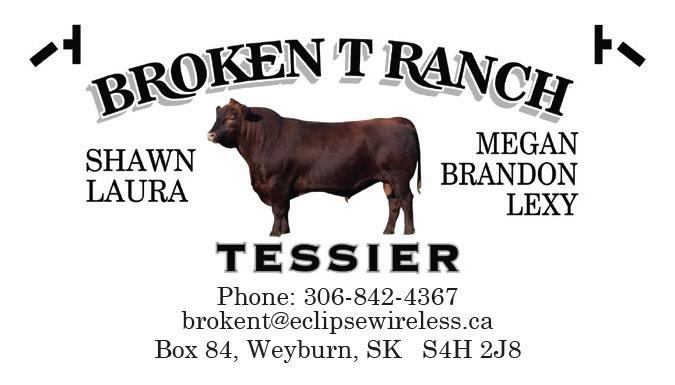





















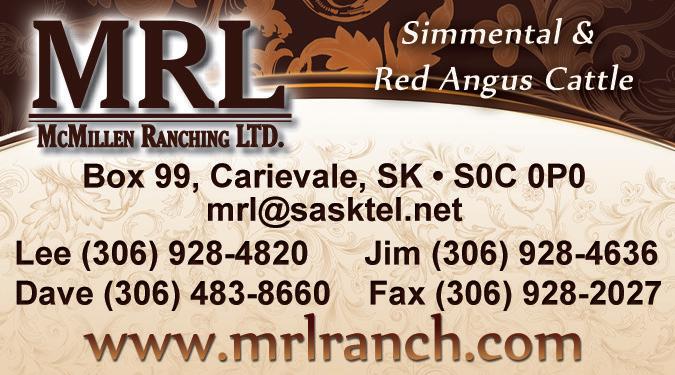










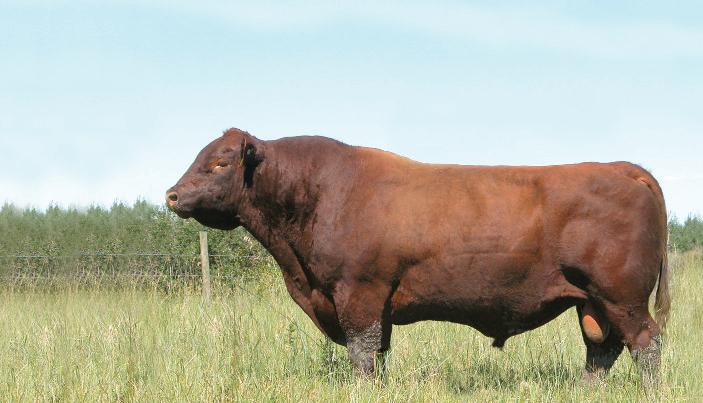





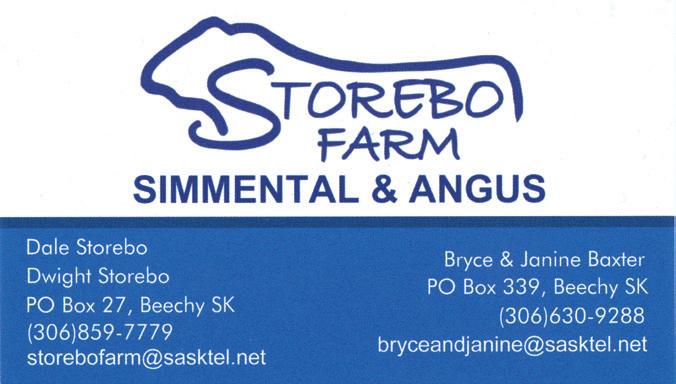









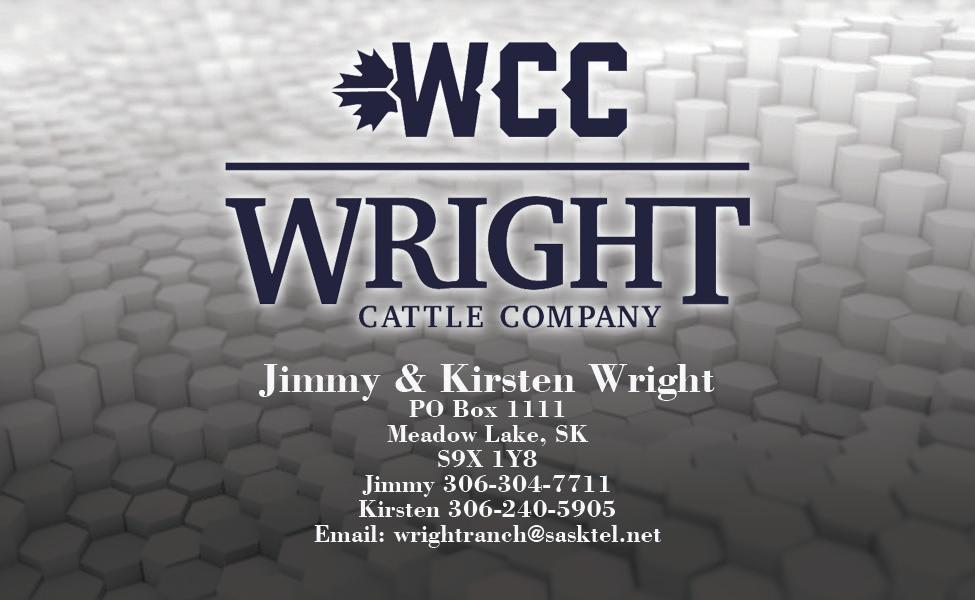












Certified Angus Beef leans in on meat science evolutions.
By Lindsay Graber Runft

Progress happens when people are at the table, engaged and committed to action. With a vested interest in the beef industry’s future, Certified Angus Beef (CAB) is leaning in on conversations surrounding evolutions in meat science.
With quality beef production still a focus, new issues have grown in priority: Accuracy in yield grade assessment and the need for increased red meat yield. They’re topics all segments of cattle production and merchandising are engaging in, with research and working groups leading the way.
Overall, the goal is to produce as many pounds of high-quality beef per carcass as possible—and to do it efficiently and sustainably.
Reaching the Science’s Lifespan
It’s been 60 years since the first yield grades were assessed on the packing plant floor, and even longer since the yield grade equation was developed. During the span of those six decades, market animal composition—alongside cattle feeding technologies and methods—has changed.
It’s no secret that the yield grade equation is due for an update, and the accuracy of it has been the subject of questions for several years.
“Sometimes our work in science has a lifespan, and we’ve got to be aware of how the market and industry evolve around us,” John Stika, CAB president, says. “We’ve always got to be willing to circle back and reconfirm whether or not the sound results we found at that time are still relevant.”
And not just yield grade, but ribeye area (REA) measurement too.
For decades, ranchers have used REA as a key indicator of muscularity in cattle. With REA as the only tool, and its relation to yield grade calculations, cattlemen have homed in on that trait for red meat yield. Via ultrasound and camera-grading systems, it’s easy to get data back that can be used to improve genetic selection.
Research by Dr. Dale Woerner, Cargill endowed professor at Texas Tech University, revealed that REA and red meat yield are only 4% related. While REA is still an important trait, it shouldn’t be the sole predictor of red meat yield.
“Ribeye area is the tool that we’ve largely put in the toolbox of breeders to improve red meat yield,” Mark McCully, chief executive officer of the American Angus Association, says. “It’s not directionally taking us the
wrong way, but we have the opportunity to collect new phenotypes for genetic evaluation that would put new tools in breeders’ hands to truly make more advanced improvement.”
A large percentage of cattle are traded on a formula and carcass-merit basis, applying pressure to the need for a consistent and precise measurement. According to Dr. Ty Lawrence, professor of animal science at West Texas A&M University, researchers can explain approximately 40% of the variation in red meat yield by yield grade, but it could be better.
Hands down: Ranchers need better tools to select for red meat yield. They need tools that can more accurately measure composition and reward producers, without a bigger REA, per hundredweight. Through changes in genetics and management, the opportunity exists to increase carcass weight, without putting on excess fat. Those “pounds of gold,” as Stika coined them, would be high-quality, saleable beef through increased red meat yield.
With quality directly tied to consumer demand for beef, it remains a high priority. Because of ranchers’ dedication, we’re currently enjoying the highest demand for beef in 30 years.
But as the industry evolves, there is a growing relevance of yield alongside quality.
“With all the improvement that we’ve made in quality, it’s still the biggest lost opportunity for us,” Stika says.
“But at the same time, because of the improvements we’ve made in quality, the relative scope of the opportunity between quality and yield grade is beginning to narrow.”
Quality has always been where CAB “hangs its hat,” but it’s not the only thing that keeps the brand relevant. A core priority for the brand and an opportunity for Angus ranchers is profitability. It gives producers a vehicle to put more dollars in their pocket, by targeting a brand favored by consumers.
“As we talk about this being an industry opportunity, it’s got to be good for everybody, meaning it can’t just benefit the packer,” Stika says. “It must produce dollars that come back to the feeder and the cow-calf producer, ultimately increasing the value of genetics that are able to hit the targets.”
Research and revolutions lead to solutions, but not without industry stakeholders coming together.
National Cattlemen’s Beef Association (NCBA) created the Red Meat Yield (RMY) Working Group to lead the discussion, support research, and engage a crosssection of experts. It includes broad representation from every segment of the beef supply chain—cowcalf producers to the packing plant and beyond, with academia, government, technology expertise, and merchandising/branded beef represented.
Key research includes how to define and calculate red meat yield by today’s standards and the processes to measure carcass composition. So far, computed tomography (CT scanning) has been deemed the “gold standard.” Its use of X-ray technology measures muscle, fat and bone at a high degree of accuracy. The challenge is incorporating it at the packing plant because of chain speeds, logistical problems and safety issues. But it can guide the RMY Working Group’s research to precisely measure red meat yield, which meat scientists can then use to investigate how it relates to saleable yield.
For the RMY Working Group, the long-term outlook is to enter industry implementation in the next 2-3 years. As the topic continues to be socialized and research wheels put into motion, CAB remains at the table and committed to supporting the industry’s work to establish an accurate measurement and increased red meat yield—alongside production efficiency, sustainability and Angus ranchers’ bottom line.









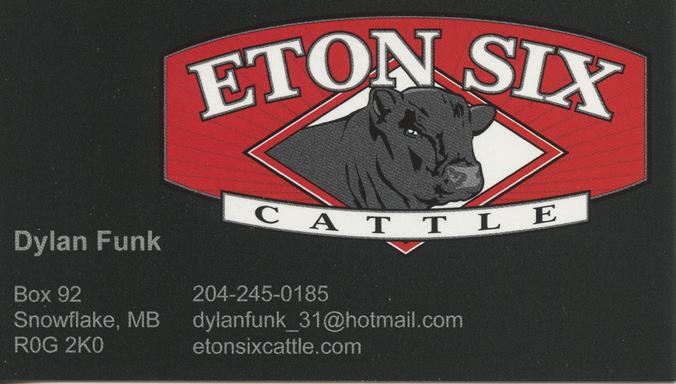








It’s time to celebrate the red, white and blue! Whether you’re in the cab of a tractor putting up hay or checking cows on grass, we hope you catch a break and spend time with family and friends as you celebrate Independence Day.
Summer for our communications team means hitting the road to visit ranches and feedyards across the U.S. and Canada. We look forward to these trips, visiting those within the beef community and capturing stories to share throughout the year.
Stay tuned for quality beef production stories from The Brand that Pays®. But in the meantime, here’s a sneak peek of where we’ve been so far!
Sysco Supports Ranchers Through Partnership with CAB
We are wrapping up the second year of the Raised with Respect™ campaign, our partnership with Sysco supporting Beef Quality Assurance (BQA). Raised with Respect™ highlights the beef community’s shared commitment to quality and helps ensure future beef demand. For cattlemen, we’ve hosted BQA trainings and giveaways to increase awareness and completion of continued education opportunities.
But what’s in it for the world’s largest protein distributor?
We know BQA helps increase consumer trust in the way cattle are raised, which happens to be their primary concern when asked what sustainability means to them related to the beef industry (Source: Consumer Beef Tracker, Jan-Dec 2021). Sysco cares because their
customers care. The Raised with Respect™ partnership provides tangible support for cattlemen and women who are putting in the work every day to take the best care of their cattle and raise the best beef.

After witnessing your commitment to cattle care, Sysco’s brought the Raised with Respect™ message to life in visible ways through meaningful partnerships and real-world moments. Whether that is in-office signage sharing the values behind the partnership and Certified Angus Beef or sending staff to a ranch for a day (pictured left) to learn more about the daily work it takes to raise high-quality beef, they’re showing up, sharing your stories and leading with purpose. Sysco Lincoln also participated in the recent Nebraska Cattlemen’s Beef Ball (pictured right) to support cancer research and celebrate the state’s ranching community.
Each year of the campaign we set a goal of 1,000 BQA certifications, and we continue to surpass that goal. This year, 1,137 BQA certificates have been reported through inperson and online training. Our thanks to those who have gotten BQA certified! Getting BQA’d, and staying BQA’d, is an important part of the beef business.
Beef
Influencing stakeholders from pasture to plate means we need a diverse staff here in Ohio at the brand’s office. Our chefs are tasked with staying tuned in to the food scene and how
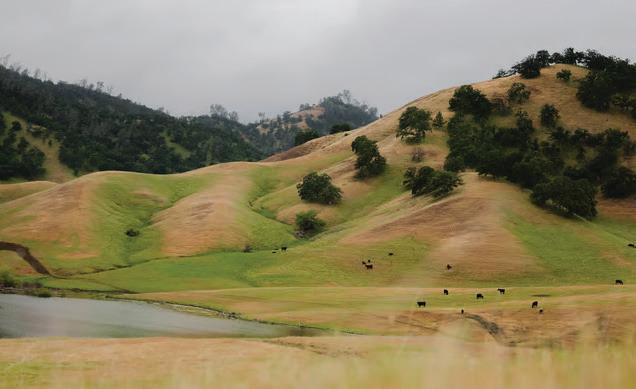
beef stays on the center of our partners’ and consumers’ plates. One way they do this is through creating recipes that incorporate the hottest, most popular food trends.
Grazing boards that offer easy snacks in the summer heat are trending this season. But not just your regular summer sausage, cheese and crackers. Heading into the Fourth of July, Chef Ashley has prepared the ultimate steak grazing board. Laying out a Certified Angus Beef ® ribeye, New York strip, and filet on a charcuterie board makes for a presentation that’s sure to make your guests’ jaws drop and have something for everyone.
For hot flavors, the National Restaurant Association’s culinary forecast lists its top 10 predictions:
Sustainability & Local Sourcing:
1. Cold Brew
2. Korean Cuisine
3. Hot Honey
4. Vietnamese Cuisine
5. Hyper-local Beer & Wine
6. Fermented/Pickled Foods
7. Wellness Drinks
8. Creative Spritzes
9. Value Deals
International flavors have been trending for a while and Chef Gavin continues to work his magic in the Test Kitchen to incorporate these flavors with beef. One of his most recent creations was a Korean Gochujang Butter to top grilled steaks.
Lindsay Graber Runft Director, Producer Communications




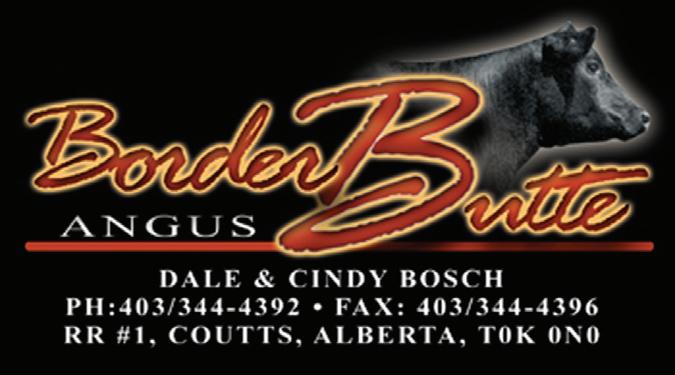



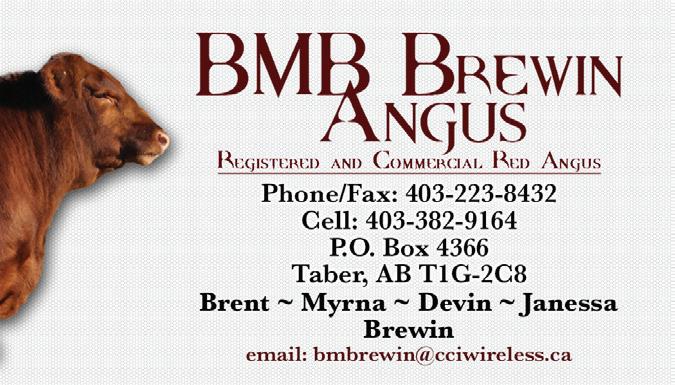



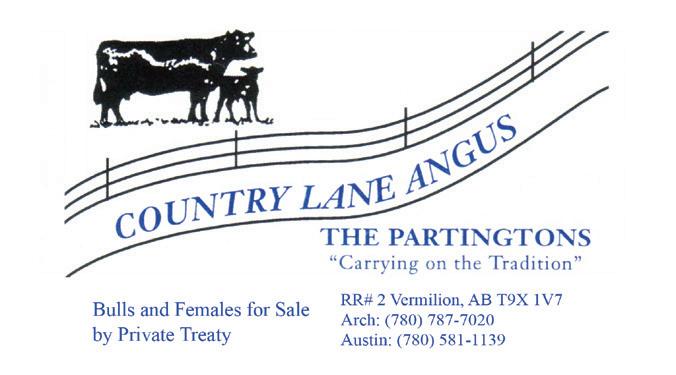



































780-675-0112 Residence: 780-675-3445















Junior delegates elect new board members at the 2025 National Junior Angus Show.
By Molly Biggs, Communications Specialist
July 18, 2025
For more information, contact: Holly Martin, director of communications: 816-383-5143 / hmartin@angus.org
From the moment the first trailer rolled into town, Tulsa was buzzing with the energy of more than just competition. For six individuals, the journey down Route 66 for the 2025 National Junior Angus Show (NJAS) led to a green coat and a new chapter of leadership as the newest members of the National Junior Angus Board (NJAB). It’s a journey that resonates with many, including newly elected NJAA Board member, Keeley Shultz.
“I grew up surrounded by Angus cattle on our family operation in Georgia,” she says. “But what inspired me to get involved with the NJAA was attending my first junior nationals in Perry, Ga., in 2009. Even though I was too young to show, watching those green jackets in the ring lit a spark, I didn’t fully understand at the time. It created a passion that I had no idea would continue fueling me all these years later.”
Developing the next generation of industry leaders is a vital component of the National Junior Angus Association (NJAA) mission. Each year, six junior members are elected to serve on the board, where they further develop their leadership skills and represent Angus. The new directors were announced during the awards ceremony at the 2025 NJAS July 4, 2025, in Tulsa, Okla.
The newly elected board members will serve a two-year term, the first year as directors and the second year as officers. The new directors are Adeline Tommell, Fonda, N.Y.; Alexis Koelling, Bowling Green, Mo.; Ava Wood, Willow Spring, N.C.; Bryce Hofing, Coatesville, Ind.; Keely Shultz, Danielsville, Ga.; and Lyle Perrier, Eureka, Kan.
During their term, directors will travel the nation to assist at shows and conferences, support junior members during state and national events and help to advance the NJAA mission.
The “new six,” will join second-term members and newly appointed chairman, Ava Leibfried of Platteville, Wis., and vice chairman, Anne Dameron of Towanda, Ill. The officer team also includes foundation director, Grant Solem, Los Olivos, Calif.; secretary, Bryanna Smith, Russell Springs, Ky,; events director, Blake Pillars of Martin, Mich.; and education director, Catie Collison of Lake City, Iowa.
Leibfried is looking forward to spending another year working alongside her fellow second-year directors and is eager to hear the ideas that the “new-six” will bring to the table.
“Watching them step into their roles and bring fresh energy to the board is something I am looking forward to,” Leibfried says. “I’m excited to explore ideas we’ve been discussing as a team for the past year and see how we might turn some of those into reality. There’s something really rewarding about taking a longdiscussed concept and watching it come to life for the benefit of our juniors.”
Adeline Tommell joins the NJAB from Fonda, N.Y. Her passion for the Angus breed began at a young age, showing cattle alongside her older brother and helping with her family’s feedyard and Angus herd. Since attending her first NJAS in 2018, Tommell has been an active member of both her state and national associations,
serving as a voting delegate and holding leadership positions within the New York Junior Angus Association.
he will be a junior at Oklahoma State University (OSU) this fall, majoring in agricultural communications with a minor in pre-law and agricultural policy.
“Growing up in New York, I always felt like agriculture wasn’t something most people around me understood,” Tommell says. “I showed Angus cattle because I loved the lifestyle, but I didn’t realize how big the community was until I joined the NJAA. Suddenly I had a network of people from across the country. That energy, combined with the leadership opportunities, is what pulled me in and kept me involved.”
Keely Shultz of Danielsville, Ga., found her passion for Angus cattle early, watching from the sidelines at the 2009 NJAS in Perry, Ga. What began as admiration quickly turned into action.
Since then, she has grown into a young leader, passionate about cattle, people and service.
Shultz currently attends OSU, where she studies agricultural communications and animal science with a focus on beef production and ranch management. She plans to pursue a career in agricultural and youth development while continuing to expand her family’s operation, Mirror K Farm.
From serving as a Georgia Junior Angus Association Director to participating in leadership events like the Leaders Engaged in Angus Development (LEAD) and Raising the Bar conferences, Shultz has seen firsthand how the NJAA shapes its members. She’s eager to give back and help others find their place within the Angus family.
“The NJAA has given me some of my best memories, from shows and contests to leadership conferences and late-night laughs with friends who feel more like family,” Shultz says. “It’s an association that truly invests in its juniors, helping us grow not just as exhibitors, but as leaders and advocates for the breed.”
Ava Wood is a second-generation Angus breeder from Willow Spring, N.C. Wood has grown up immersed in the Angus breed. In 2025, she served as president of the North Carolina Junior Angus Association and chaired the Junior Board of the Atlantic National Angus Show.
She currently attends North Carolina State University, where she is studying agribusiness management. Through her education and hands-on experience working on her family’s farm, Wood has developed an interest in business and marketing. She is passionate about helping juniors find their place within the association and develop skills beyond the showring.
“I want to help younger members feel more confident in getting involved,” Wood says. “Whether it’s their first show, or first time competing in a contest, I want to be someone they can come to for advice or encouragement.”
Bryce Hofing of Coatesville, Ind., has grown up within the NJAA and is passionate about giving back to the organization that has shaped his leadership journey.
Hofing recently graduated from Cascade High School and will attend Kansas State University (K-State) this fall, majoring in Construction Science and Management. He currently serves as Vice President of the Indiana Junior Angus Association and Vice Chairman of the Junior Board of the Atlantic National Angus Show. He also holds leadership positions with the Indiana Junior Beef Cattle Association.
Hofing is excited to serve alongside this group of leaders and to continue building connections within the Angus breed.
“What I love about the Angus breed and the NJAA is how it brings people together across generations, blending tradition with opportunity,” Hofing says. “The NJAA gives junior members a place to grow, lead and dream of their future opportunities within agriculture.”
Alexis Koelling

of Bowling Green, Mo., has been immersed in agriculture from a young age, balancing time between the show barn, hay field and classroom.
She is currently studying agricultural communications and agribusiness at OSU, where she continues to build on her foundation in the livestock industry. Koelling looks forward to the opportunity to serve as a role model and mentor through the NJAB.
“It means a great deal to me to represent junior members on the board,” Koelling says. “I’m incredibly grateful for the opportunity to support and mentor others, just as past board members once did for me. Their guidance and encouragement played a big role in my development, and I’m honored to now be in a position to give back. I’m looking forward to helping junior members feel welcomed and empowered as they grow as young leaders.”
Lyle Perrier of Eureka, Kan., is a lifelong Angus enthusiast who grew up on his family’s registered Angus operation. From a young age, his days were filled with helping on the ranch, participating in livestock evaluation contests and being actively involved in 4-H and FFA.
Perrier is currently majoring in animal sciences and industry at K-State, where he serves as an assistant business manager for Farmhouse Fraternity, a member of the Student Alumni Board and an Animal Sciences and Industry Mentor. He also holds leadership roles with the Kansas Angus Association and the university’s Collegiate Cattlemen’s Club.
Perrier is honored to join this exceptional group of junior leaders and represent the Angus breed on a national level.
“I hope to support junior members by being a board member who is never scared to do the dirty work, never afraid to make hard decisions and never too cool to talk with a member at a conference,” Perrier says. “This mindset will help impact members in one-on-one settings around the barns and at conferences throughout the year. I hope to be a strong leader within the boardroom and around the barns.”
To learn more about the NJAB, visit www.angus.org/NJAA/home/board.
View results of the 2025 NJAS, including shows, contests, awards and scholarships at www.njas.info. Additional coverage is also available on the NJAA Facebook page and in the September issue of the Angus Journal.
Established as a 501(c)(3) organization in 1980, the Angus Foundation remains focused on its mission to support Angus education, youth, and research. The organization has distributed more than $4.9 million in youth scholarships since 1998 and has also invested more than $1.4 million in beef cattle research in the past decade.
For more information, contact the Angus Foundation at 816-383-5100.
ANGUS MEANS BUSINESS. The American Angus Association® is the nation’s largest beef breed organization, serving more than 21,000 members across the United States, Canada and several other countries. It’s home to an extensive breed registry that grows by more than 300,000 animals each year. The Association also provides programs and services to farmers, ranchers and others who rely on Angus to produce quality genetics for the beef industry and quality beef for consumers.
For more information about Angus cattle and the American Angus Association, visit www. angus.org.















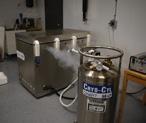




















Bryan Kostiuk Editor 306-933-4200 C: 306-292-7763
Chris Poley Marketing C: 306-220-5006
Shane Michelson Marketing C: 403-363-9973
We appreciate your interest in Today’s Angus Advantage and hope you have enjoyed this issue. To receive further issues, please fill out the following subscription form and return it along with your payment (prices listed below) to:
Today’s Angus Advantage Box 2330, Warman, SK S0K 4S0 P: 306-933-4200 info@todaysangus.com www.todaysangus.com
Please check one of the following:
□ Canada $50.00 TAX Included □ United Staes $60.00 TAX Included □ International $60.00 USD
Make cheques payable to Today’s Angus Advantage Farm Name
Ben Wright Marketing C: 519-374-3335
Levi Rimke Marketing C: 204-851-4515
Deadline Material Deadline Camera Ready Deadline
Buyers Guide Special Issue - Herd Sire Issue January 2 January 6 January 13 Spring Issue - Female Issue April 17 April 22 April 27 Summer Issue - Early Sales & Prospects July 10 July 15 July 22
ADVERTISING RATES *Plus GST/HST - Yearly Contract discount 15% (Card Ads Exempt) Standard Issue
□ We would like to advertise in your next issue, please contact me. □ Renewal Credit Card Payment □ MasterCard □ Visa Name ___________________________________________ Card Number: ____________________________________ CVC ______________ Expiry Date ___________________





Emmaline Usselman
Kiana Salmasi
Kylie Willms

why its worth the wait and worth the drive for the LT prefix
1. Structurally sound and proven longevity- grown on a high fiber diet (Zero Corn)
2. Proven feed efficiency in the pasture and feedlot
3. Strong carcass merits resulting in higher yielding and grading carcasses
4. Strong Fertility resulting in more pregnancies and pounds of red meat produced - All bulls semen tested prior to sale day!
5. Quality- Top 50% of bulls on test in the offering!
6. Affordability - Bulls to fit the commercial rancher’s price point while still maintaining top quality
7. Volume- Midwest’s largest bull offering
8. Strong Maternal traits balanced with top performance
9 Desirable Docility- Resulting in better feed intakes and higher average gains
10. Highest Customer service in the industry- Unmatched customer buyback program (Over 60,000 head fed and marketed in 2024/2025)


Blair’s Corprate Law 505M
Blair’s Civil Law 574M
Blair’s Private Law 506M
Blair’s State Law 527M
Blair’s Law & Order 532M
Blair’s International Law 510M
Blair’s Business Law 509M
Feb 9, 2026 Feb 9, 2026 They Sell






